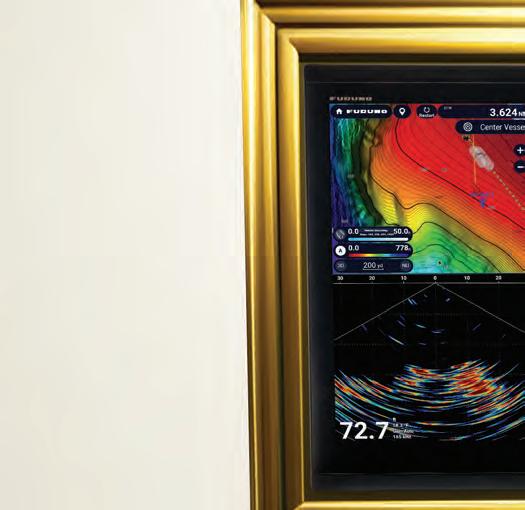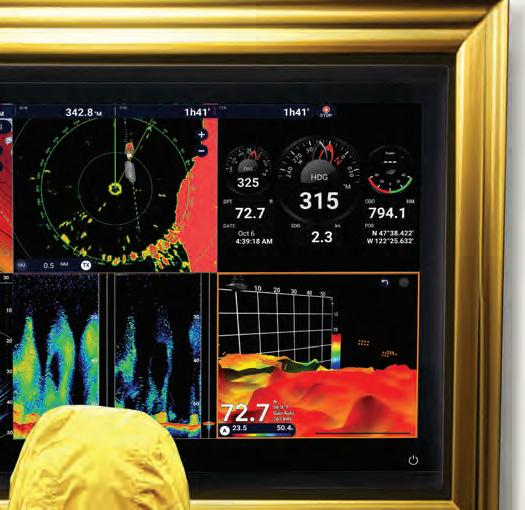












































































































Whether your vessel options are limited or you just want to spice up your inshore fshing experience, fshing from a kayak should not be overlooked as a possibility. When done correctly, it is some of the most exciting fshing. It can also be modifed for the extreme, or an entirely leisure day on the water.
Kayaking is how I fell in love with fshing. Of all the diferent ways I have gone about it, I have enjoyed them all. From packing a lunch and fshing my way to an island for a picnic and a swim, to drifing backcountry mangroves other vessels cannot access, to cruising dock lights at night, or deploying in
1,300 feet of water seeking yellowfn tuna of of the oil rigs, kayak fshing is versatile with endless possibilities.
Tis type of fshing can be dangerous, and its especially important to know your limitations and be overly prepared. Currents and wind change quickly and afect your return trip. Make sure to check tides and weather before venturing or drifing too far. Paddling against the current while battling the extreme heat can put you in a bad situation very quickly. Make sure to have a small anchor onboard as well. Obviously, this will come in handy for fshing, and it can also provide an opportunity to rest if exhaustion is getting the best of you.
Decking out your rig for fshing is an art form, and there are many ways to go about it. Prioritize having a cooler attached to the back over all else. You do not want to get dehydrated out there. Aferall, you are the motor of the vessel, and should be well maintained just like any other motor.
Afx everything to your kayak with the expectation of getting fipped. Of course, do everything to keep yourself from that situation, but things happen. Use dry-storage bags, and clip everything to the kayak itself. Most kayaks are designed to make this a straightforward process.
Fishing artifcials will simplify your set up, but sometimes afer all the paddling, its nice to relax and toss out some live bait. A bait bucket on a rope with shrimp, that can be tossed out between paddles, should be all you need. For more extreme fshing, modify a PVC pipe with holes drilled into it to hold live baitfsh.
Use common sense and check local regulations. Protect yourself from the sun during the day, be properly lit at night, and stay out of high-trafc boating areas and channels. You are also required to carry a PFD and a sound producing device, such as a whistle.
Once you have hit the full safety checklist, go out there and experience the possibilities that kayak fshing has to ofer. Fishing from a kayak will intensify the tug even with smaller fsh you hook up to, so hang on and enjoy the aquatic sleigh ride.
Capt. Quinlyn Haddon guides with Sweet E’Nuf Charters out of Marathon, Fla. See Captainquinlyn.com, @captainquinlyn or call (504) 920-6342.
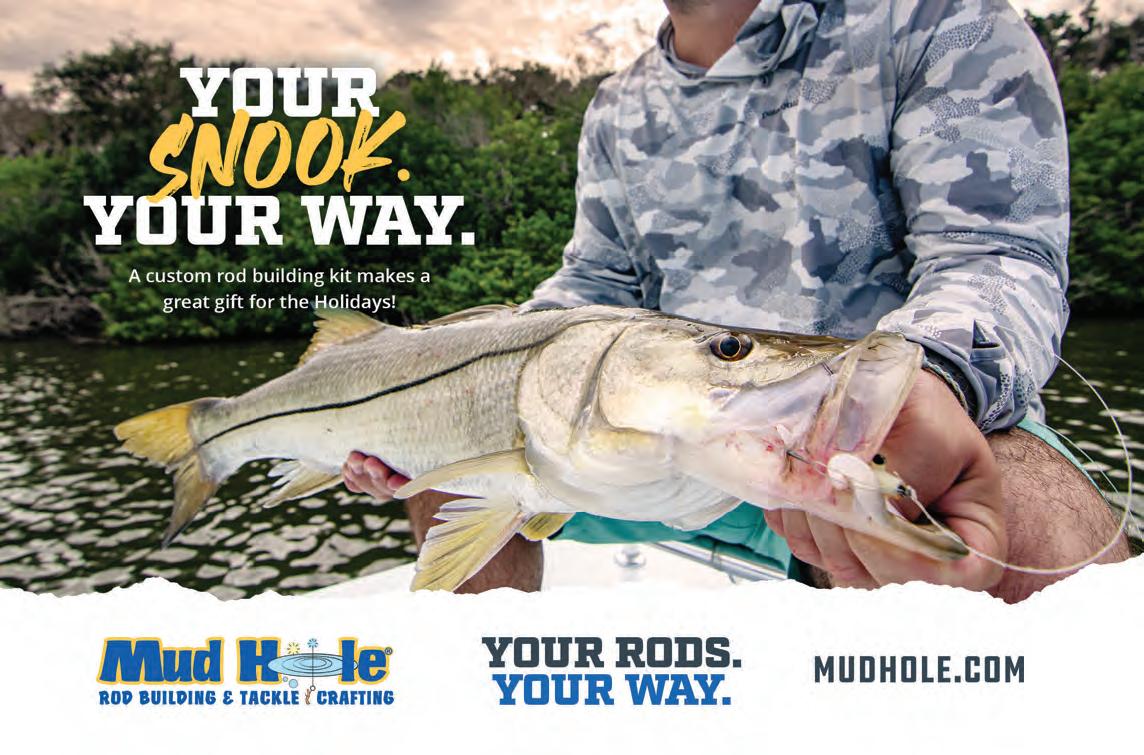





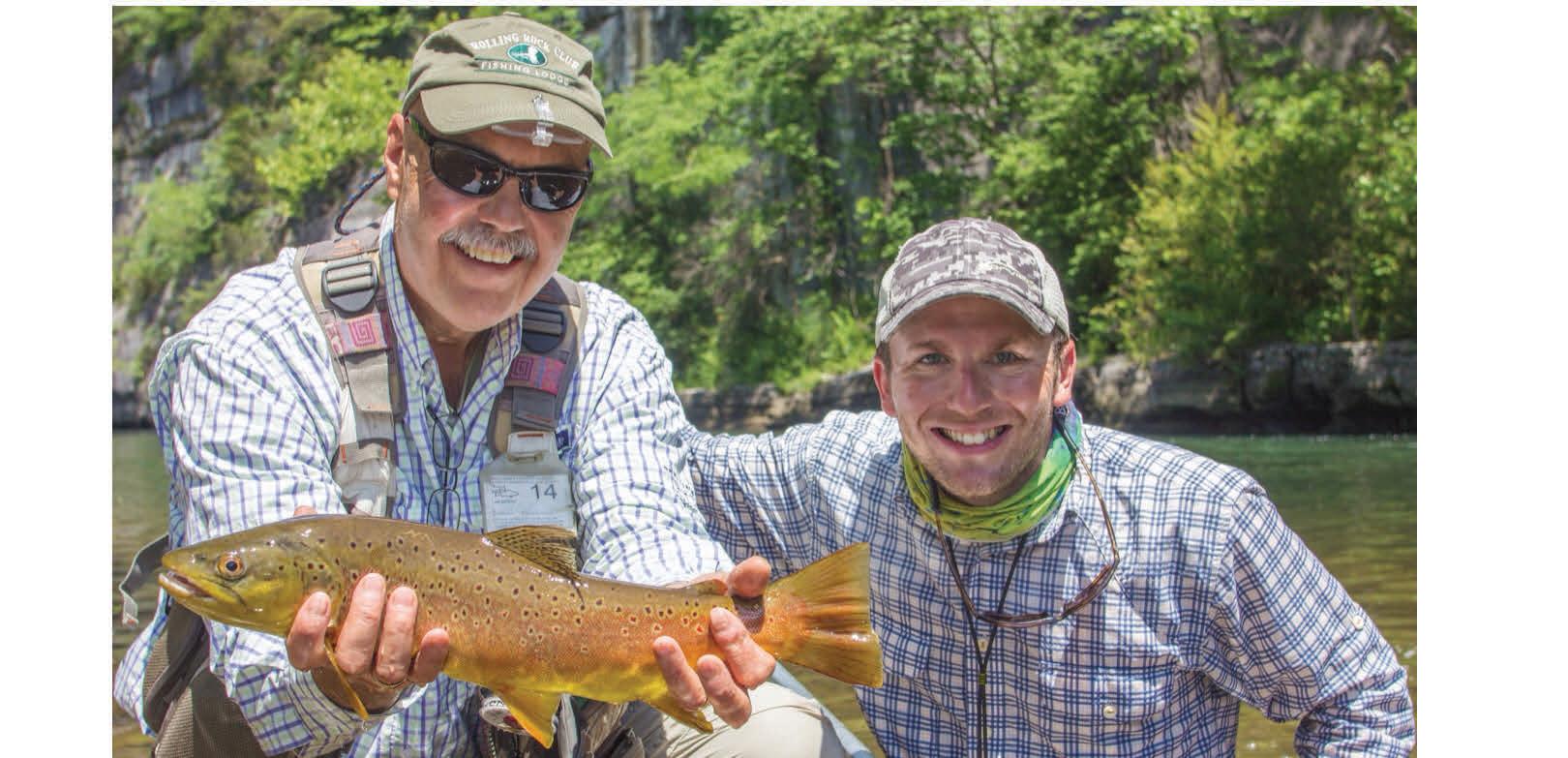



Hybrid striped bass are the Franken-fsh of anglers’ dreams. Also known as wipers, sunshine bass and other names, they are hatchery-produced crossbreeds of white bass and striped bass. Tey are stocked into reservoirs across the country for angler enjoyment.
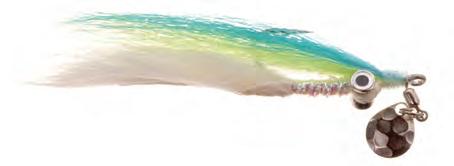
Central Georgia’s Lake Oconee is a hybrid hot spot. Georgia stocks hundreds of thousands of hybrids in the lake, and conventional anglers get afer them with live baits, jigging spoons, bucktails and trolling lures.
Capt. Wayne Moore, of Oconee on the Fly guide service, is probably the only guy you’ll see on Oconee waving a fy rod from his center console. While he admits conventional tactics are more efective, there are three situations when fy fshing is both productive and a boatload of fun.
Oconee is a 19,000-acre impoundment about an hour and a half drive east of Atlanta. Te lake backs up behind a pump-back dam that creates currents that are key to a good hybrid bite. Moore said there is ofen a good afernoon bite when the dam kicks on and hybrids move onto main-lake points to chase threadfn shad. Afer locating bait and fsh with electronics, Moore goes to work on them with 8-weight fy rods and intermediate sinktip lines. He fshes a cadence of fve short strips and a pause with a 2-inch long white/chartreuse Clouser on a 5-foot leader of 12- to 15-pound
fuorocarbon.
When the bite is hot, a good angler might boat 8 to 10 fsh, and 4- to 6-pound hybrids are not uncommon. “A 6-pound hybrid is going to fght like a 10-pound striper,” Moore said.
By Nick Carter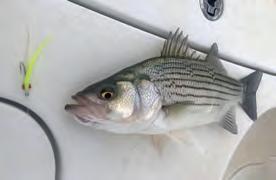

A fy rod is also fun for the mid-lake morning bite. When the water starts moving, hybrids herd shad to the surface and blow up on them in a frenzy. Te action only lasts an hour, but the bite is consistent for two or three weeks during the May shad spawn.
With thousands of newly hatched shad in the water, Cowen’s Somethin’ Else, and Cowen’s Coyote are Moore’s go-to fies. Henry Cowen is a legendary angler and fy tier who developed patterns specifcally for striped bass in Georgia waters. His fies work just as well on hybrids.
Night fshing under the lights is another situation when Moore would rather use a fy rod.
“We don’t have a lot of lit docks here, but the
ones that are lit will be covered with fsh,” he said. Casts must be precise, and the fghts are technical, so Moore reserves night trips for experienced fy fshers.
“You better have that 15-pound leader. A 6-pound hybrid will give you a run for your money,” he said. “Tey’ll run you right back under that dock.”
With the May schooling bite approaching, it’s worth making plans to visit Oconee now…or try these tactics on your local hybrid reservoir.
Contact Wayne Moore at (404) 317-9556 or wmoore1700@outlook.com and check out Oconee on the Fly at www.oconeeonthefy.com.





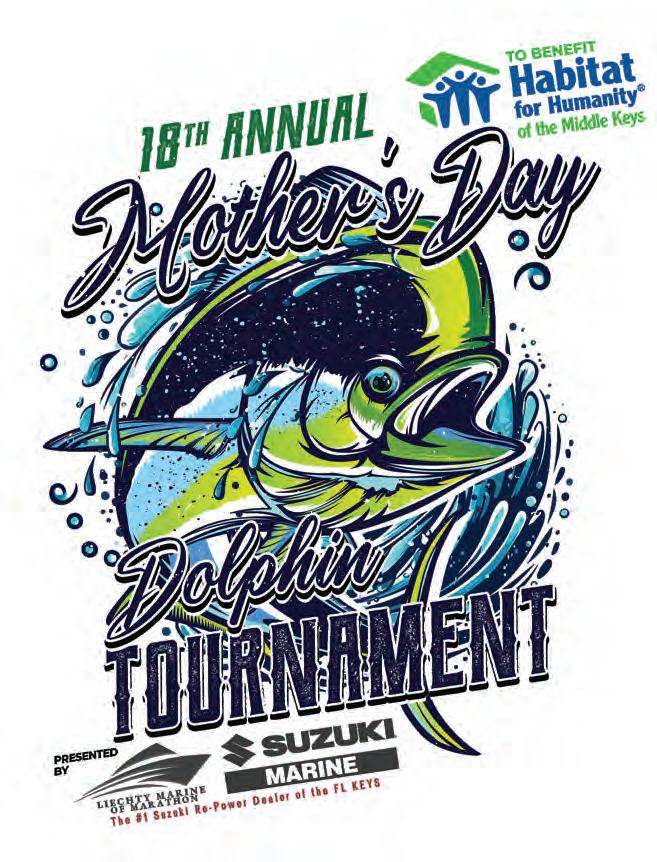

May 10th & 11th, 2024
Online Registration:
MothersDayDolphinTournament.com
Captain’s Meeting
The Island Fish Co.
Friday May 10th - 6pm to 7pm
Lines In: Saturday, May 11 - 7:30am
Lines Out: Saturday, May 11 - 3:30pm
Weigh-In
Curly’s Cofee
Saturday, May 11th - 3:30pm to 6pm
Awards Banquet
Marathon Yacht Club
Saturday, May 11th - 7pm
Sunday Honor Our Moms
Always in our Hearts JB!

An Angler TournamentAngler Entry Fee is a Donation
Catagories
Ladies, Junior (16 and under), Weekend Warrior and Pro Prizes for 1st, 2nd and 3rd in all categories
Contact Chris Todd Young at 305-797-5779
Admin@HabitatMiddleKeys.org
Presented by




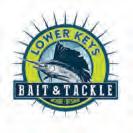








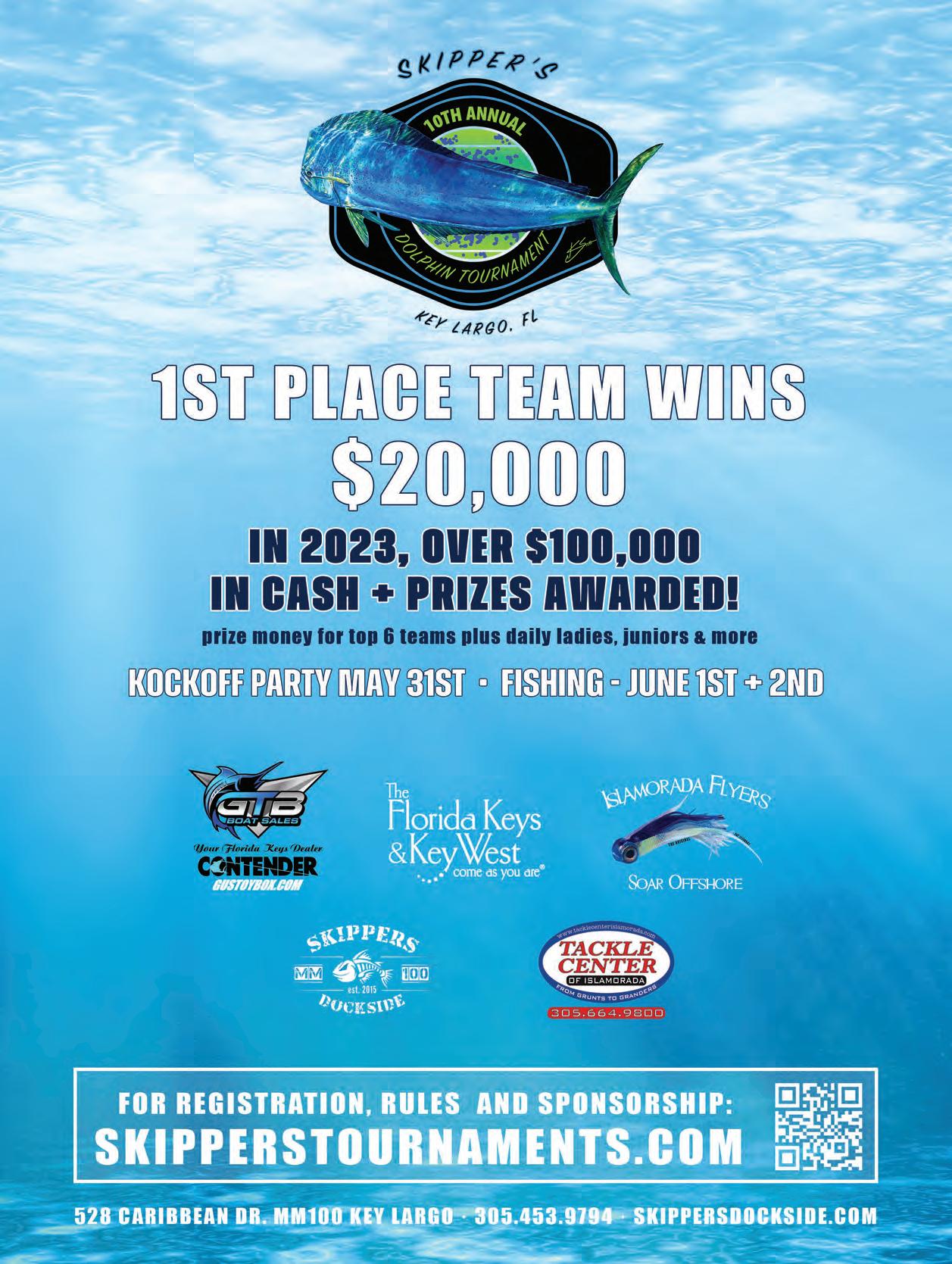







Trophy bass fshing in Alachua County was already good. With recently approved regulations intended to grow trophy bass, many anglers and the Florida Fish and Wildlife Conservation Commission are hoping it will get even better.
Orange Lake and Lochloosa Lake will both be managed under new regulations, which prohibit killing or possessing any black bass that is 20 inches or longer. Also, the new rules require the use of non-ofset circle hooks when fshing with natural baits longer than 3 inches in length. Te regulations are designed to allow trophy bass to remain in the lakes to grow larger and to minimize injury to fsh caught with natural baits. Bass ofen swallow live baits prior to the hook set, and circle hooks are designed so they are more likely than other hook styles to hook fsh in the lip, rather than in the gullet.
“Florida bass need to have the right genetics and waterbody conditions to grow for a long time,” said FWC Commissioner Gary Lester. “Orange Lake is unique, like in its fuctuations in water levels, that makes ideal conditions for bass to reach record sizes.”
Indeed, Orange Lake has established itself as one of the top trophy bass lakes in the state. It produces numerous 10-plus-pound largemouth bass every year, as documented by the Florida TrophyCatch program. Already in 2024, anglers have caught, released and reported eight 10-pluspounders to the program, and this fgure doesn’t include all the fsh caught by anglers who don’t participate in TrophyCatch. Te largest Orange Lake bass this year, so far, was a monster 13-pound, 4-ounce fsh caught by Luke Bolling on Feb. 15.
Lochloosa is not as much of a trophy bass factory as its sister lake, but it does pump out several 8- to 11-pounders for the Trophy Catch program each year. Both lakes are in Alachua County southwest of Gainesville.
Tese regulations changes support FWC’s eforts to grow larger trophy
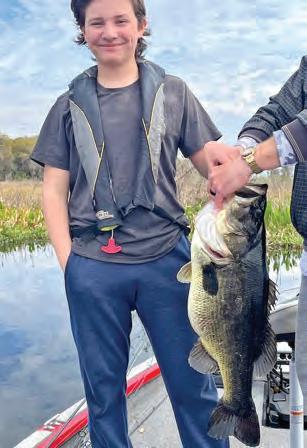

bass across the state and allow bass in these lakes to reach their maximum growth potential.



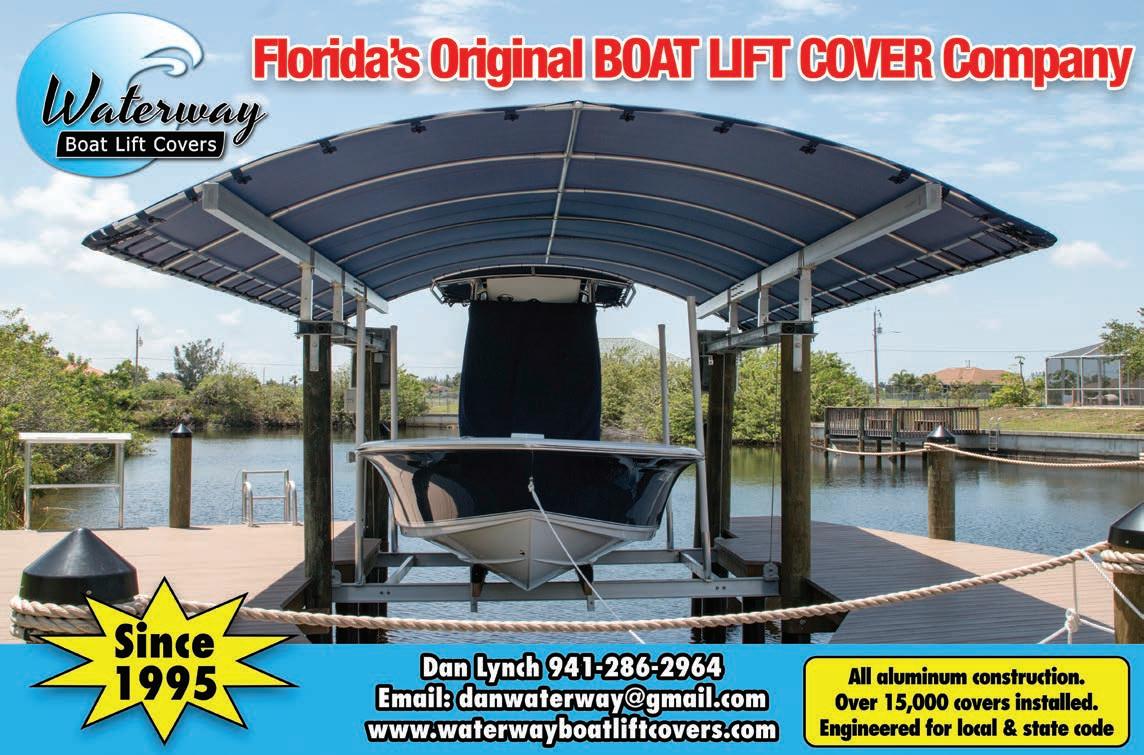
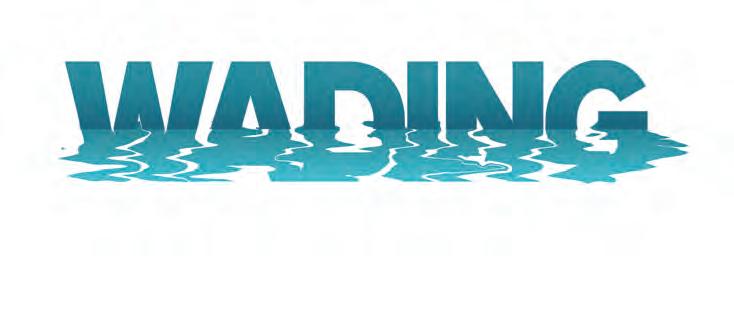
In my years of fshing the Indian River Lagoon, some of my best fshing has been wading.
Tere’s nothing like being in the water with the fsh. It provides advantages you don’t have in a boat. Wading is the most silent and efective way to fsh shallow water. Tere are lots of places you can access the lagoon, and all of them have fsh.
WADERS : You need a pair of chest waders because of the changing water quality, and you can get a good pair for less than $100. Waders protect you from underwater obstacles as well as cold or dirty water. In Florida, neoprene waders are too hot for most of the year. I prefer vinyl waders. If it’s cold, you can wear jogging pants under them.
Waders come with boots attached or sof shoe, which require rubber boots to wear over them. Make sure you don’t get the boot size too small. Wading boots can be very uncomfortable if they are too tight. Wear socks and get a larger boot.
GEAR: I recommend a good spinning reel with a 9- or 10-foot rod for longer casting. I use braided line because it’s strong and the smaller diameter of the line is better for casting. I use 6to 10-pound braid most of the time with 2-foot fuorocarbon leader. I use a 25-pound leader but have used 20- to 40-pound leaders in diferent situations. Carry extra leaders and lures in case your line breaks.
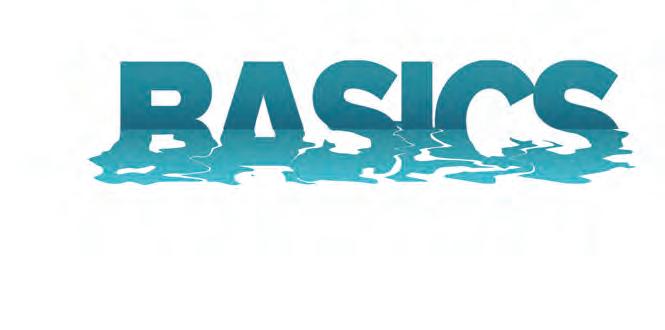
My main lures are search lures for making lots of casts and covering wide areas of water quickly. My favorite lure is a ¼-ounce jig with a sof-plastic body. I use D.O.A. jigs with a chartreuse head rigged with a pearl white paddletail (D.O.A. Shad Tail). It swims but is not erratic, and it’s easy for fsh to locate by sight and vibration. Te other search lures I use are shallow-running crankbaits (Yo-Zuri Inshore in pearl white), topwater lures (Skitterwalk/Zara Spook or Chug Plug), and spoons (Johnson silver or gold). Te jig covers shallow and deep water and can be skipped under piers and mangroves.
WIND: Too much wind, and it’s too hard to fsh. Not enough wind, and the fsh are hard to catch. It’s easier to fsh with the wind at your back because you can cast farther. To get the right wind, you can fsh either the east side or the west side of the lagoon. Most of the time there is an easterly wind. If it’s too windy, fsh around the Stuart bridges, which almost completely block the wind.
LOCATIONS: I wade the southern Indian River Lagoon from Sebastian to Jupiter, mostly between Fort Pierce and Stuart. Here are my favorite spots:
West Side—Walton Road (intersection with Indian River Rd) and Walton Scrub; Midway Road and Old Fort Park in Fort Pierce; and both Stuart Bridges.
There’s still a pompano bite on the beaches and in the lagoon. Jig from the bridges or wade while fan casting with jigs. Look for birds and bait to fnd bluefsh, jacks and ladyfsh. Snook will still be deep, but on warm days they will run the beach from the inlets and be around the deeper piers in the lagoon. Redfsh are around the deeper piers.
East Side—Bear Point then Blind Creek in Fort Pierce; North and South Herman’s Bay in St. Lucie; and both Stuart Bridges.
Richard L. Matteson is a long-time contributor to Coastal Angler Magazine who reports for the Stuart Rod and Reel Club.

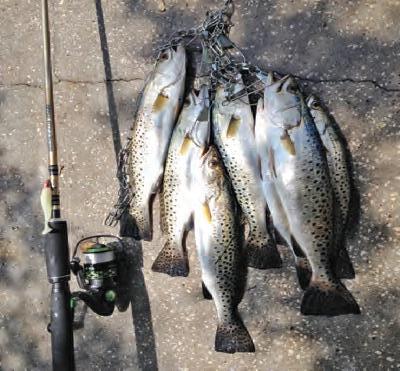
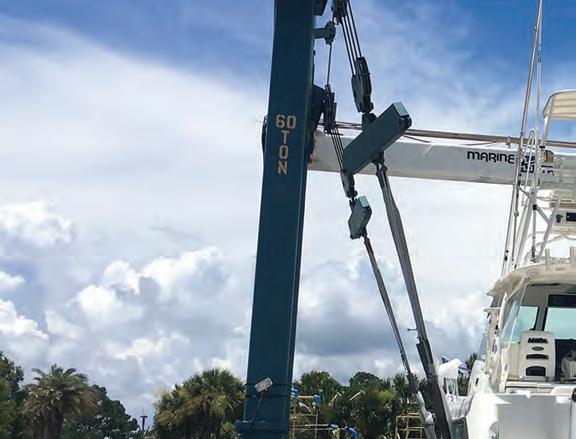













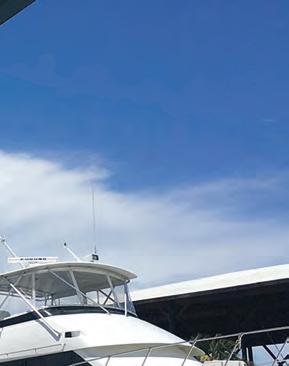







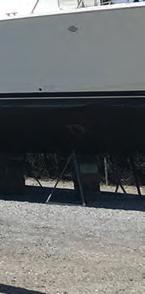







Durable boat lifts expertly designed with Florida in mind.

ShoreStation hydraulic boat lifts are a reliable choice for coastal residents and boating enthusiasts alike. Their strong construction, made with corrosion-resistant materials, allows them to withstand harsh environmental conditions, including sun, storms, and saltwater damage. ShoreStation provides a steadfast solution for protecting waterfront investments, ofering peace of mind to owners in the Sunshine State.


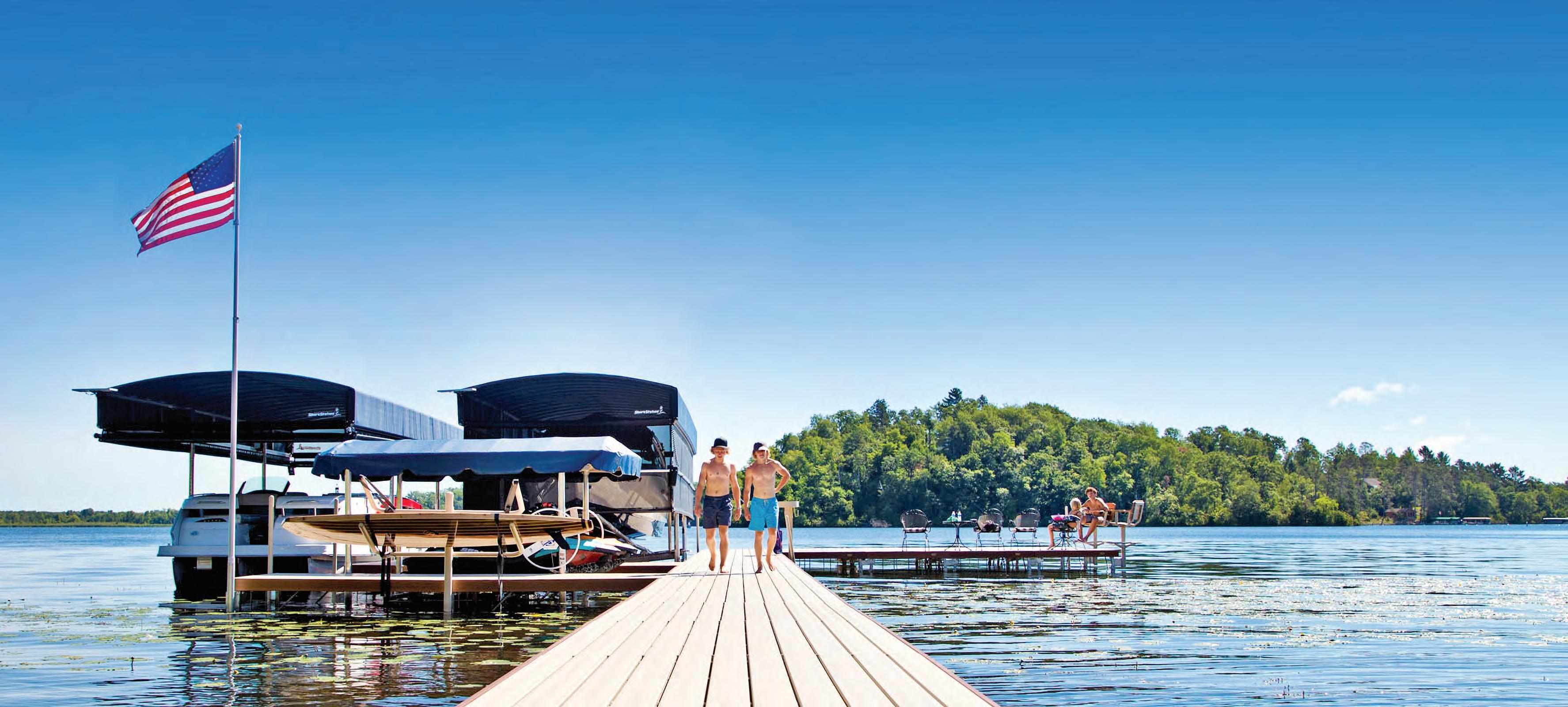
 No Profle Boat Lift
Four Piling Boat Lift
No Profle Boat Lift
Four Piling Boat Lift


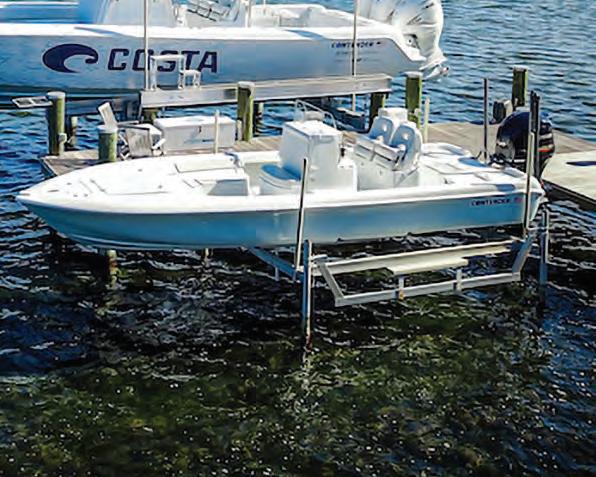
Equipped with exceptional weather resistant fabric and breathable SunTex 80 woven mesh ends for maximum protection and durability,

Made from the highest quality materials, our innovative hydraulic boat lift is one of the fastest and safest lifts on the market today. When you have a hydraulic lift, there’s no need to worry about wind and waves getting in your way. This lift will give you confdence to safely land and secure your boat in less-than-ideal conditions.
Never miss another moment on the water. Power your lift with clean, free solar power. Our speedy 20 watt charger features solar regulator drainage protection, saving your battery from permanent damage caused by overcharging.



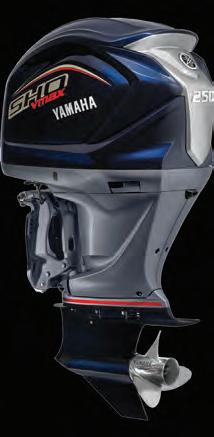
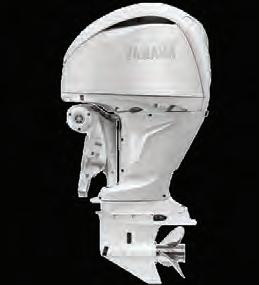


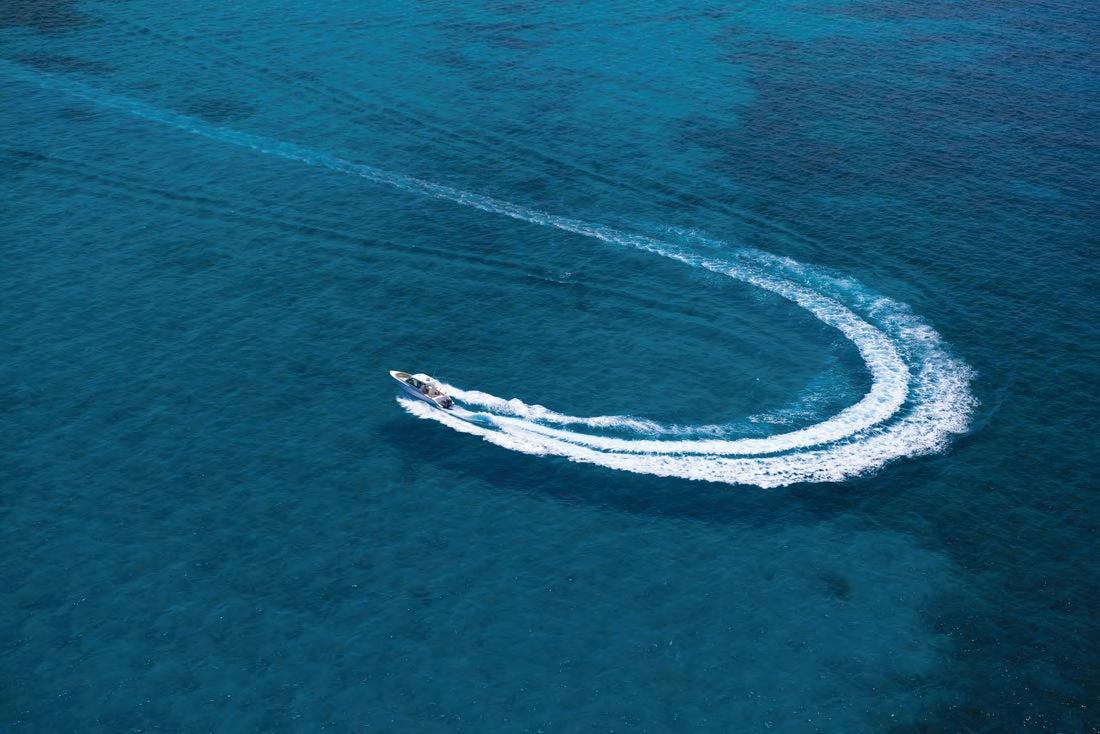




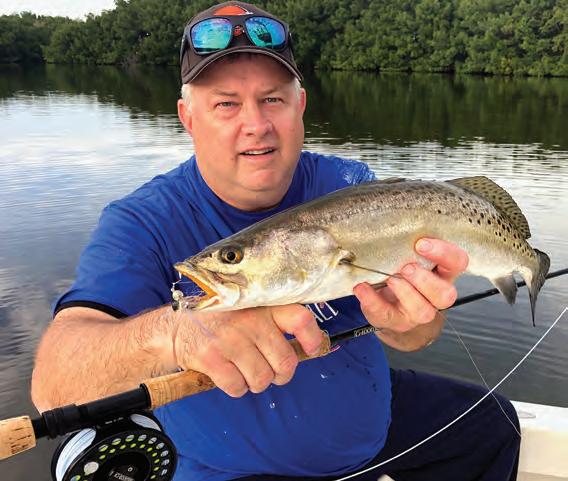


Every year, when Spring rolls around, the grass flats throughout Tampa Bay come alive. As baitfish start moving onto the flats, snook, redfish and seatrout follow. When this occurs, it’s the easiest time to achieve an inshore slam. If you don’t know what that is, it’s when you catch slot-size (or over) snook, redfish and seatrout on the same outing.
Now, many of you may think that should be easy. Well, it’s easier said than done for some people. You’d be surprised how many people who have been fishing with me that have never caught a slam. Occasionally, I meet a few anglers who have lived in the Tampa Bay area and fished all their life, but the slam eludes them.
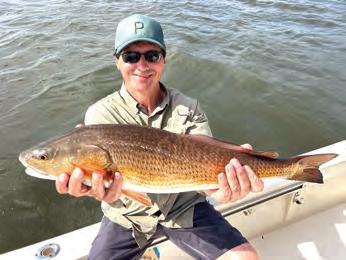
If an inshore slam is something you would like to pursue, you might assume that catching a slot-size seatrout would be the easiest and save that for last. Not necessarily--at times it can be the most difficult to land. That’s Continued on page 21
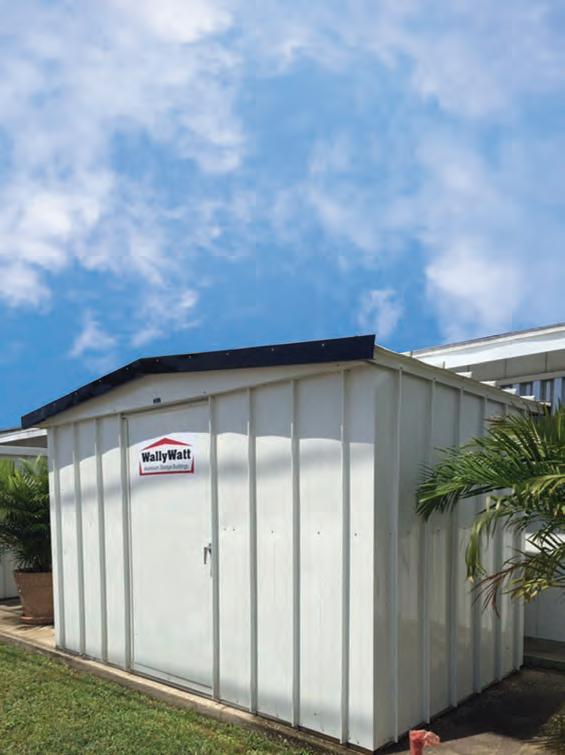

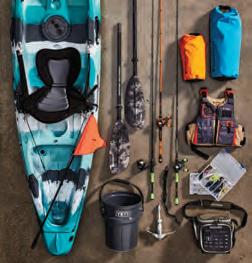

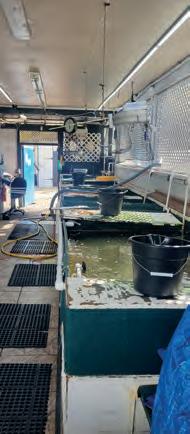



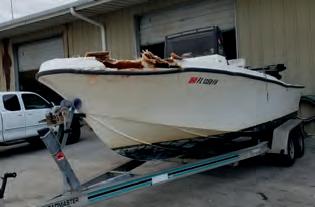
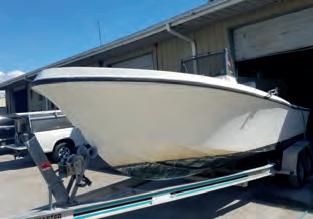 BY: CAPT. ANTHONY CORCELLA
BY: CAPT. ANTHONY CORCELLA


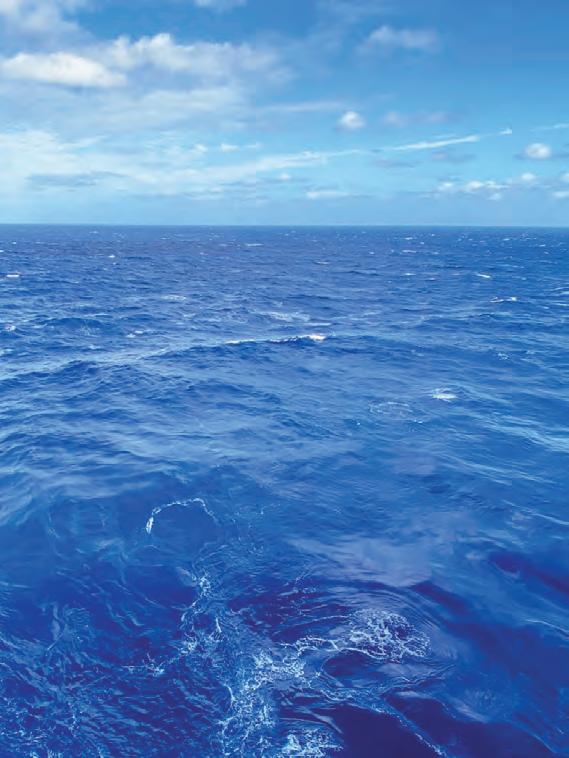

That time of year when big cobia start showing up inshore is upon us. This means it’s time to dust off the heavy spinning gear.
My personal favorite
cobia set up is a 7-foot Star Rod with 30 or 40-pound braid. The reel of choice for me is a 5500 Penn SSV. My favorite rigs for these monsters are big corks with four feet of 40-pound fluorocarbon leader and 5/0 Owner hooks.
You can either find the bait on the surface in the grass flats or chum them up. With a few good throws of a cast net or a little time and sabiki rig (both available at St. Pete Fishing Outfitters), you will have some nice greenbacks and pinfish.
To target cobia, put on a lively bait and throw it on the edge of the grass flats. While you’re waiting patiently for the cobia, get yourself a light action spinning rod and throw some D.O.A shrimp for speckled trout. I use a Star Rod when targeting trout; I like a seven-footer with an 8 to 15-pound line rating, 20-pound fluorocarbon leader and a Penn 3500 SSV.
I choose Star Rods and Penn Reels for a number of reasons. The main reason why I like Star Rods is that they can take a beating. They are also lightweight, comfortable and their warranty is one of the best on the market.
The Penn SSV and Slammer 3 are very durable and are water tight. Their drags are strong and smooth as well. I use these reels on my charters daily, and they get fished hard without issue.
Put these tips to use and you’ll set yourself up for some great springtime fishing.
— What makes our charter service unique is that we cater to disabled veterans and wheel chair bound clients! Our boat is able to accommodate wheelchairs and is ADA compliant. IF YOU’RE A DISABLED VETERAN, YOUR TRIP IS FREE! This is our way of giving back to our veterans.
Capt. Anthony Corcella, Pocket Change Inshore Fishing Charter 727-432-6446

Rising above everything else that exists naturally in the Everglades, the Mahogany Tree casts shade over an otherwise sweltering Spring day. Mahogany Trees grow on pockets of dry land under the protection of the Everglades National Park. Once much more abundant, the trees create habitat for many birds, plants, snakes and other animals that live here. Their wood has historically been harvested to create some of the finest furniture and other items over time. Luckily, in the Everglades and many parks in South Florida, we can still easily find them today.
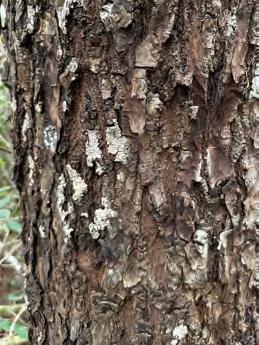
Mahogany Trees grow to as tall as 200 feet. This provides a high vantage point lookout for predators to look for prey and vice versa. Air plants and other plants also rely on the trees as an escape from the low-lying areas and floods. Their fruit looks like an upward growing pear.

One of the best places to see large Mahogany Trees up close and personally is the aptly named Mahogany Hammock within Everglades National Park. Here, there’s a naturally occurring hammock island with a boardwalk that will take you on a shaded walk beneath the trees. Here, you will find everything from small snakes and birds to tree snails using the shelter to carry out their Everglades day. Stop by next time you’re in South Florida for a great place for a cool bag lunch!
— Captain Wes Tallyn was raised in Florida and is a fisherman, birder, avid outdoorsman, photographer, and environmental scientist.
Wes has a focus on conservation and education in the community and is the owner of Snook Jam Outdoors. You can find him on Instagram @snookjam or call 727-410-5853.
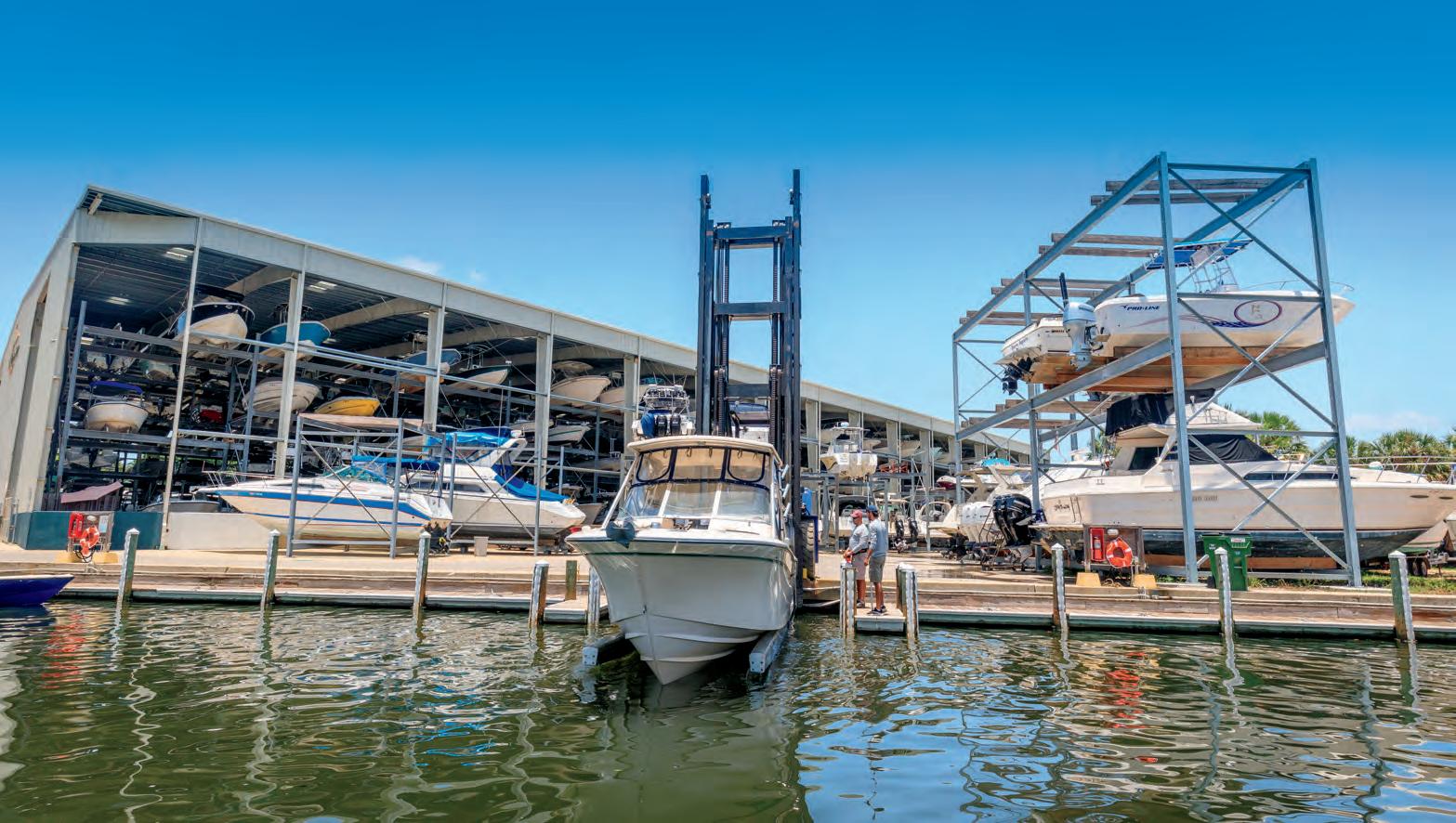



This is arguably the best time of year to get in on one of the best bites around. Spotted Seatrout, or Cynoscion nebulosusone, scientifically speaking, one of the “big three” gamefish in our area, begin to spawn in March. They are multiple spawners, meaning they spawn many times throughout an extended spawning season that can run through mid-September in the Tampa Bay Area. For the angler, this means lots of concentrated fish and an amazing bite.
Many anglers like to target seatrout in shallow grass beds where they can be found year-round. Almost any healthy, lush sea grass bed will hold some trout. Slow drifting across these flats is a great way to find these fish, and it can be a ton of fun throwing hard-body lures and soft plastics on light spin tackle or fly. But, there’s another terrain to explore that is enticing.
During late Winter and early Spring, spawning seatrout begin to group up around
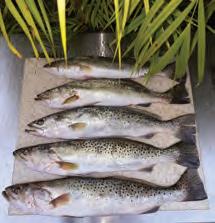





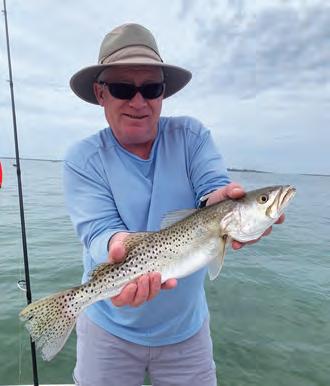
the FWC website for more information on the regulations by geographical area.
My last spotted seatrout mission put me in the southern region of the FWC map, where the limit is three fish per harvester, with a slot limit of not less than 15 inches nor greater than 19 inches total length. The harvester may possess one fish over 19 inches, per vessel; or, if fishing from shore, one over 19 inches per person, included in the bag limit. A buddy and I chose a spot we’ve fished for decades, and it wasn’t long before we found a huge pile of fish with the smallest landed at 17 inches. We also caught a number of fish over the 20-inch mark. So, not only can you find them thick, but big! Our bag limit was six fish between the two of us, but we kept only five fatties. As the saying goes, try not to catch your limit, but limit your catch, so that this resource will be around for future generations.
Not everyone likes to eat these species, but if you cook ‘em up right, spotted seatrout can be terrific. If you harvest, it’s important to keep these fish on ice, as the meat tends to become soft and mushy, if it gets too hot. My favorite way to cook trout is the good ol’ southern tradition, and that’s with hot grease. Fried trout makes great fish tacos. There are, of course, endless recipes online, but you can’t go wrong with frying.
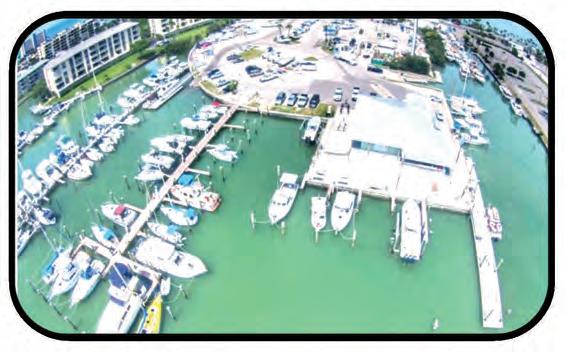
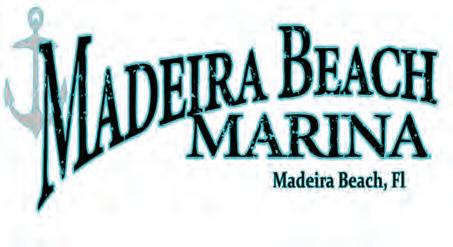
— Joshua Broer, a Tarpon Springs native, is the Facility Manager for the College of Arts & Sciences at USF. His specialties include flats and bass fishing, fly fishing, and sea kayaking. Reach him at joshua.broer@gmail.com. 503









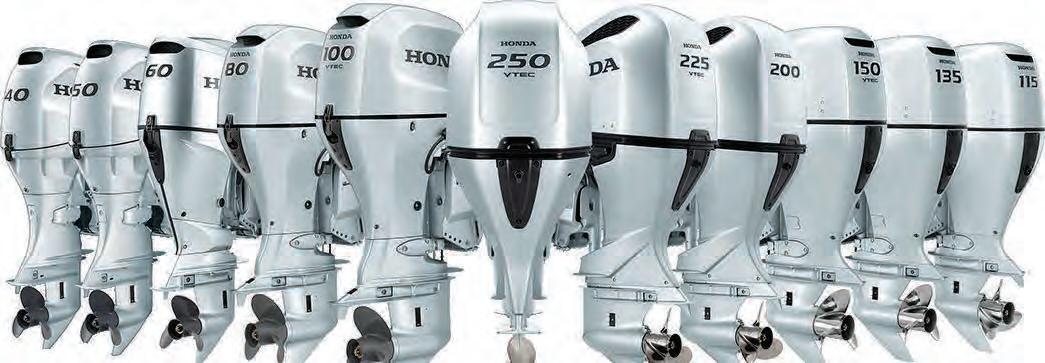








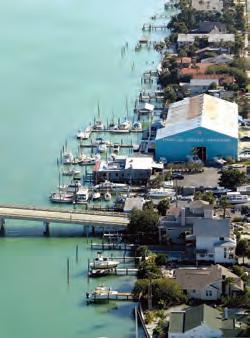

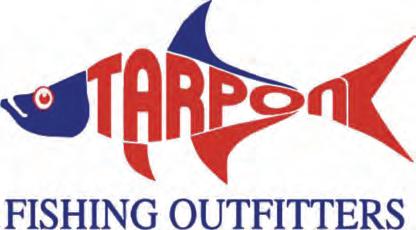
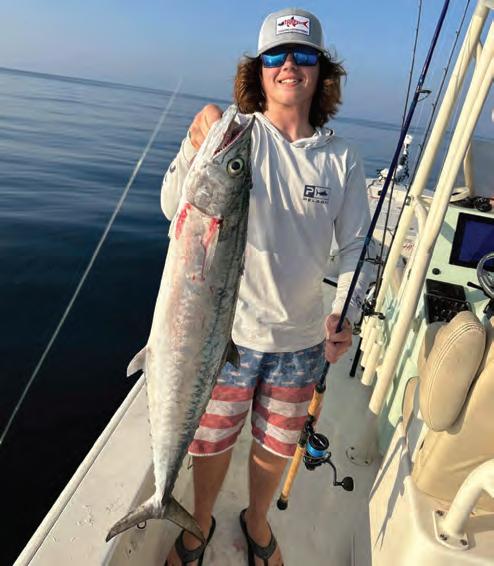


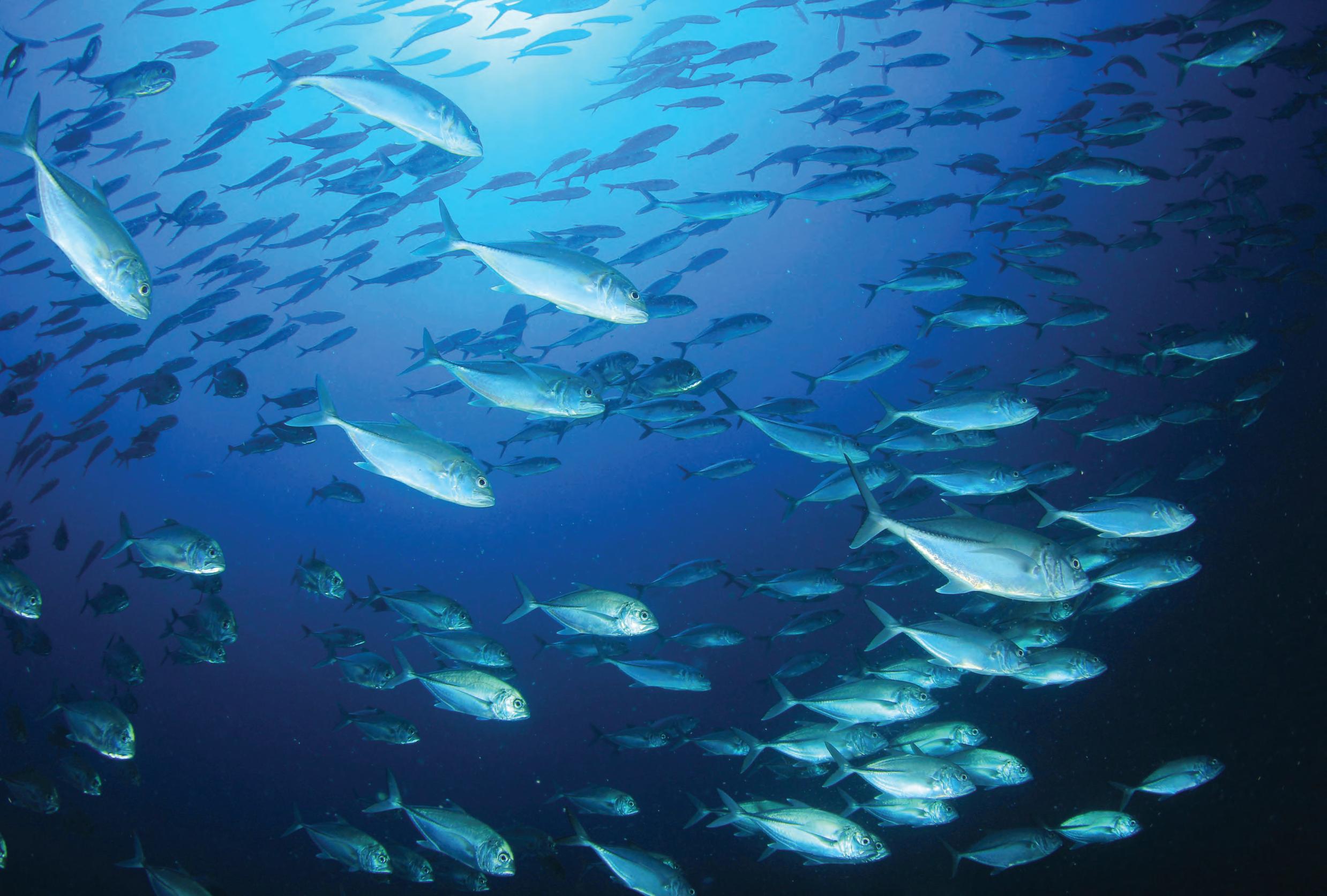


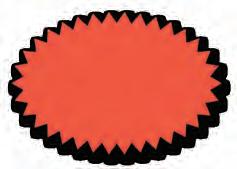

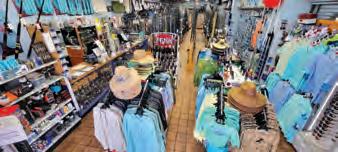
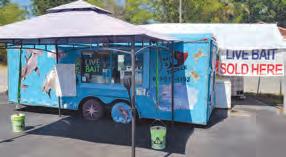
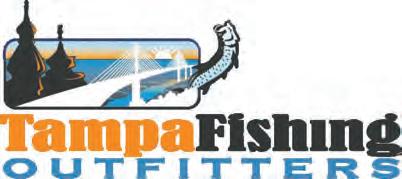
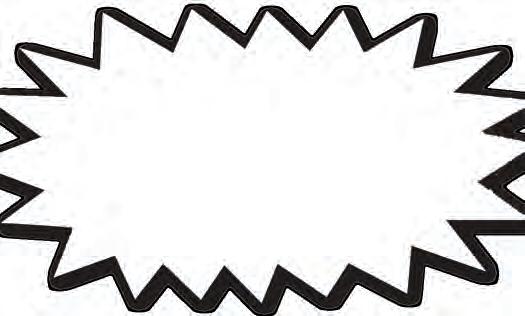


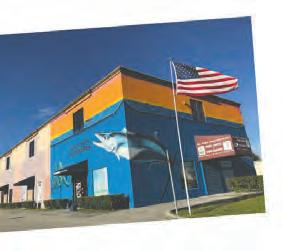
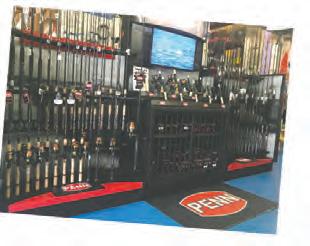






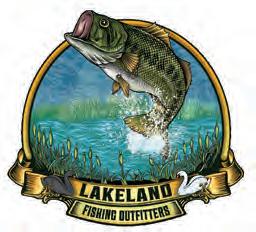


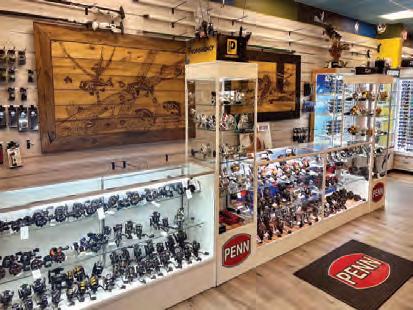



Shrimp
Pinfish
Fiddler Crabs (seasonal)
Pilchards (seasonal)
Frozen Bait
ROD REPAIRS
CUSTOM ROD BUILDS
REELS, LINE & TACKLE
1106 94th Ave. N. St. Pete HOURS
Monday - Saturday 6am - 7pm
Sunday 6am - 5pm

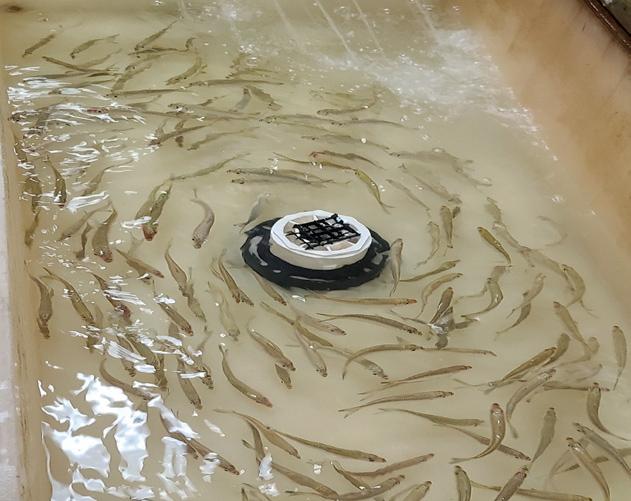
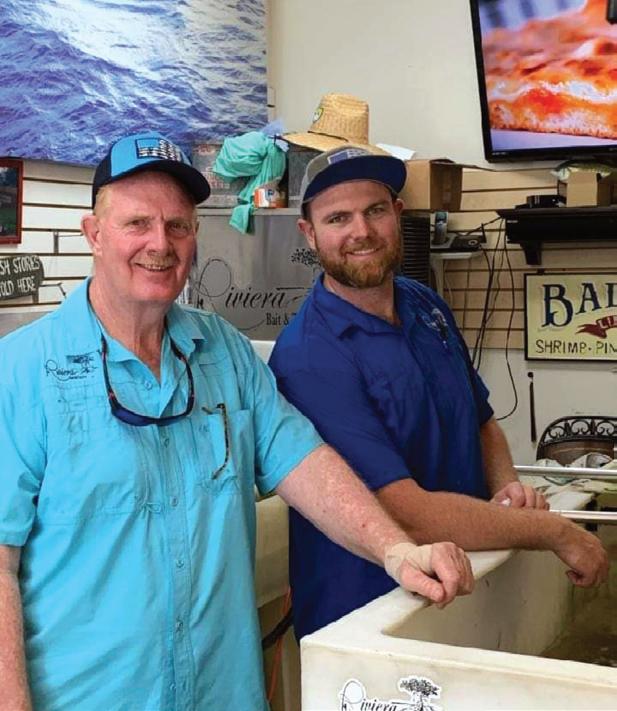
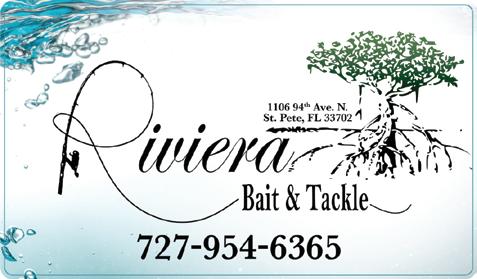
Introducing Riviera Bait and Tackle, a family-owned shop making waves since 2021. Founded by a dynamic father-son duo, they’re all about making fishing easy, whether you’re just dipping your toes or a seasoned pro. It’s not your average store; it’s where the local angling community comes together.
Riviera Bait and Tackle has big plans on the horizon – think expansion to keep up with the demand for their top-notch gear. But they’re not stopping there. Imagine monthly seminars where you can pick up new tricks and share your fishing tales. And here’s the kicker – random parties and tournaments just for the heck of it. So, if you’re into quality gear, good advice and a laid-back vibe, Riviera Bait and Tackle is the go-to spot.
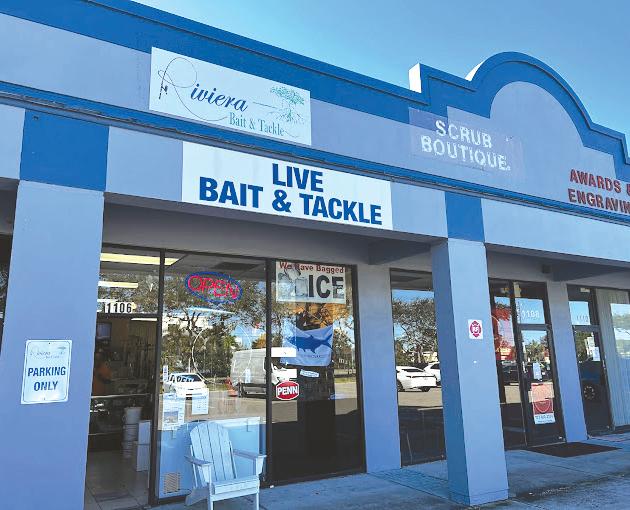







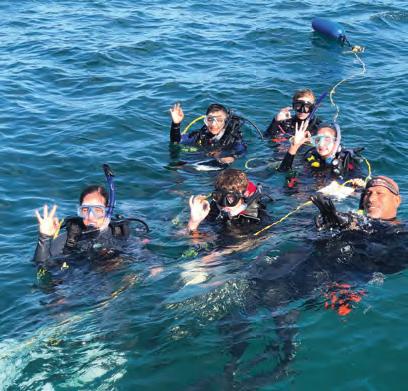
 CBY: CAPT. T J SHEA
CBY: CAPT. T J SHEA
learwater, Florida has a pleasant ring to it. If you’re a water bug, a very inviting one. If I was looking for a beach or water-filled vacation, just by the name alone, Clearwater would have to be at the top of my list. First incorporated in 1891, Clearwater was given her name from one of the many springs that can be found on land, like right next to where the City Hall building stands today. There are also numerous springs just offshore and in the surrounding intercoastal waterways. When the land was being settled in the early 1800s, it was referred to as “clear water” due to the crystal-clear waters in Tampa Bay and adjacent streams. I am sure the waters of the Gulf of Mexico looked much the same back then.


Nowadays, our near shore waters often do not have that same clarity as years past. Not to say that our water is dirty or polluted, it’s just not as “clear” as it was before the area became such a popular destination to both live and visit. Rain, storm surge and runoff from our farmlands are all key contributing factors, which diminish the Gulf of Mexico’s visibility. Despite having the State’s largest artificial reef program for many years, this area is not known as a dive destination due to the lack of consistent clear water. That being said, if there was a time to get a glimpse of what the waters may have looked like when the Tocobaga Indians controlled the land. April is it. Traditionally, April is the month when visibility is at its peak. Light winds are the order of the day and calm seas usually greet boaters and beachgoers the majority of the month. We don’t see much rain and the dry conditions on land keep fertilizers and pesticides out of our rivers and tributaries that feed the Gulf twice a day. Crystal clear water can be found at our beaches and sandbars, and offshore visibility rivals that of many of our neighboring Caribbean vacation destinations. Top to bottom is actually accurate rather than an exaggerated fishtail. So, if you have not yet dusted off your scuba gear or given the Gulf a recent visibility check, come jump in with us and see what we have to offer.
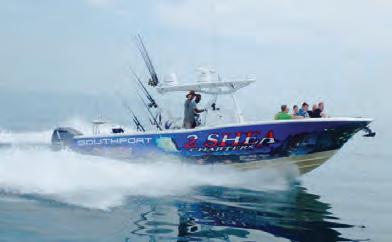


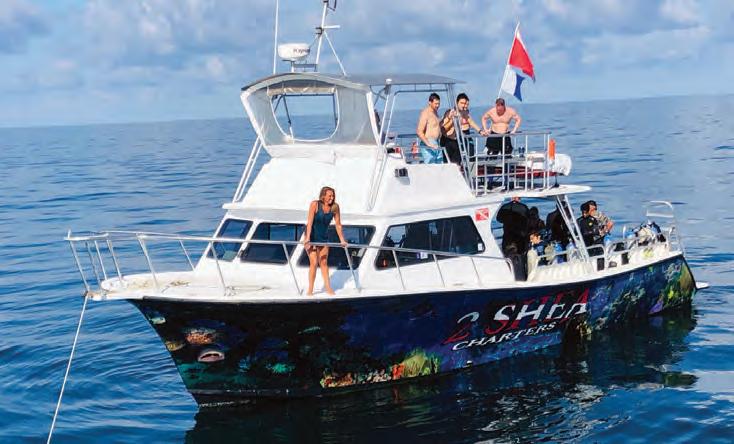
— Capt. TJ Shea. Owner/Operator 2 Shea Fishing and Diving Charters. TJ has been exploring above and below the Gulf of Mexico since he was 8 years old. Contact us at 813-385-2169 and at info@fishanddivetampa.com
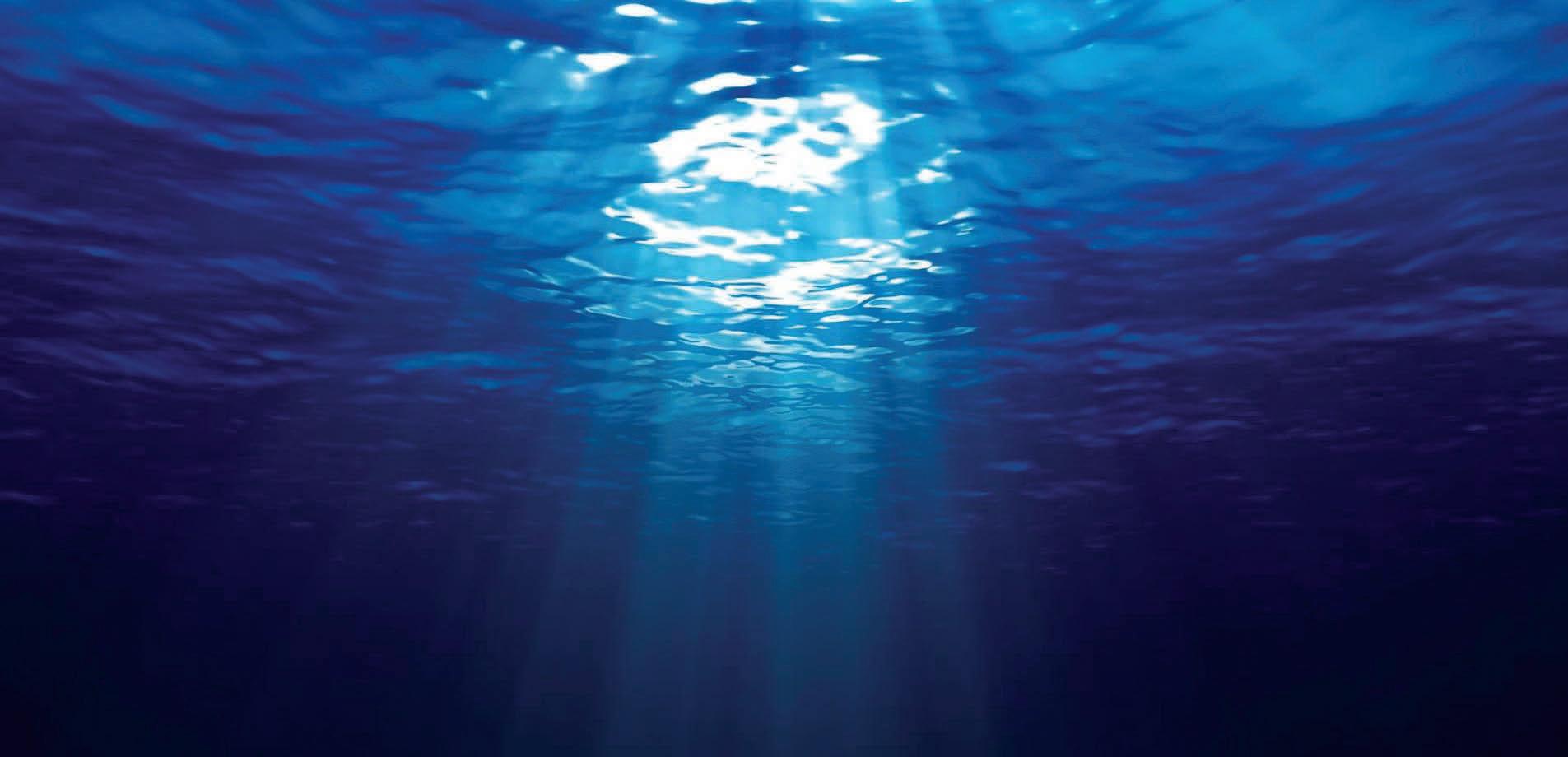
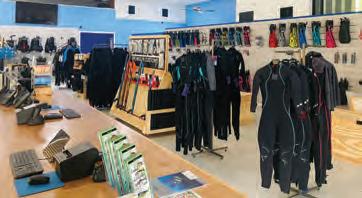

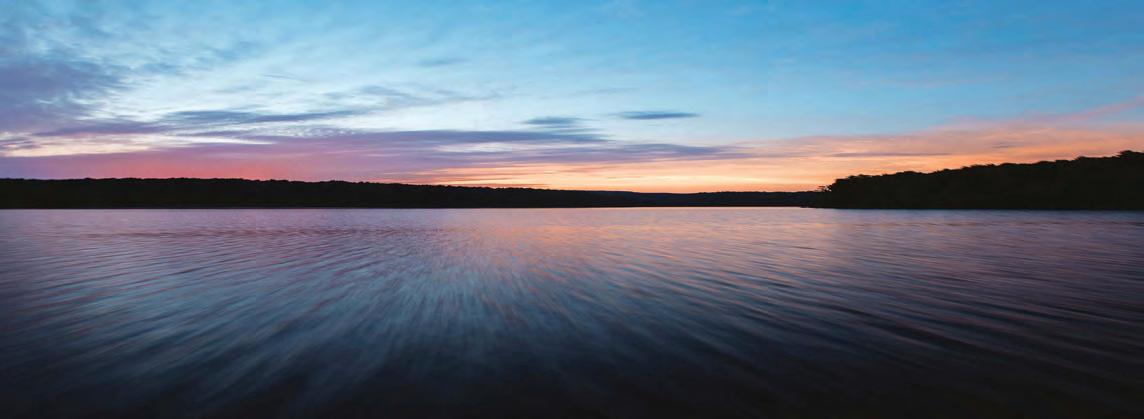




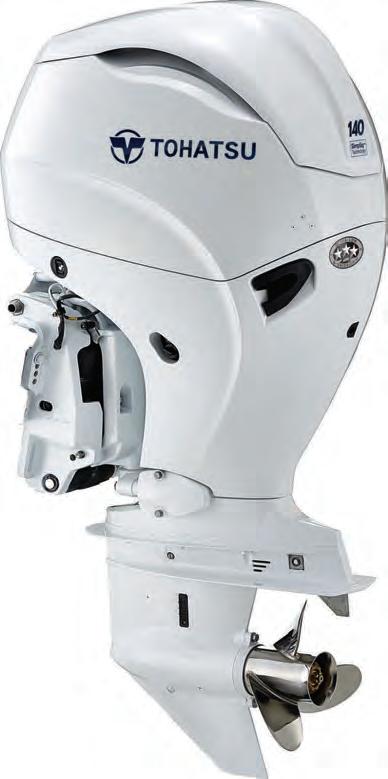



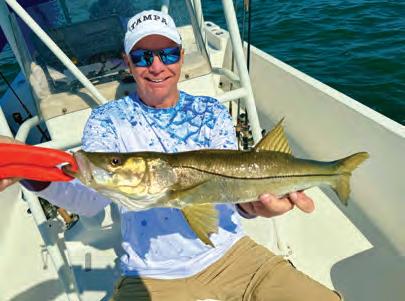
Snook is one of my favorite fish to target. Even though I have many favorites, it is in my top three.
April is a great month to target these linesiders. The bait has shown up in numbers and the snook have their feedbags on and, with a good presentation, you will get hooked up to one of these great fighting fish. They give such a spectacular fight with their topwater explosiveness, their rocket like runs, jumps and gill raking head shakes! It is everything you could ask for, out of an inshore predator fish. They are definitely an ambush fish with explosive strikes that can be memorable.
My typical set up is a 7-foot 6-inch medium heavy spinning rod 8 to17pound having a moderate-fast taper spooled with Fins 10 to 15-pound braid. I use 4 to 5 feet of 25-pound Seaguar fluorocarbon leader and a 1/0 to 2/0



light wire Owner circle hook. Adjust the hook size to the size of the bait you are using. This is the typical set up for fishing in the flats and along the mangroves during the day.
I saw two beasts, made the cast and watched as my bait got chased up into 1.5 feet of water and get hammered...
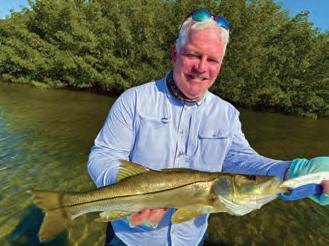
Now, nighttime is a different story. You can run heavier tackle to fish the bridges like Gandy, John’s Pass, Howard Franklin and the Courtney Cambell along with many other local smaller bridges that will hold some large snook. Since you will be fishing around the pilings, you will have to up your mainline and leader, along with your hook size, depending on what bait you are throwing. At night, you can get away with 40 to 50-pound leader to help get those large snook out from the pilings. During the day, because they can see the leader, you usually would not get a bite, unless the water you are fishing is deep enough to hide the leader due to less light at the deeper depths. When fishing the larger bridges, you will have to add weight, like an egg sinker, to keep your bait down near the pilings. A slip egg sinker rig is a nice set up for this, since you can get the lead to the bottom and then let line out to get the bait just in front of or next to the piling. Pinfish are a great bait when fishing deep structure like this, since they will











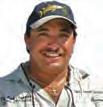
swim down most of the time without any weight.
During the day, scaled sardines is a great choice freelined along and under the mangroves.
Myself, I like fishing light tackle during the day and being able to see that large 30 to 40inch snook chase my bait down and demolish it! On my best day with a client, we caught three snook in a row over 40 inches in three feet of water. After my client caught two, he asked me if I wanted to take a shot and I couldn’t pass up the opportunity. So, I saw two beasts, made the cast and watched as my bait got chased up into 1.5 feet of water and get hammered, so the third one in a row was nailed. It was a day to remember.
Tight Lines
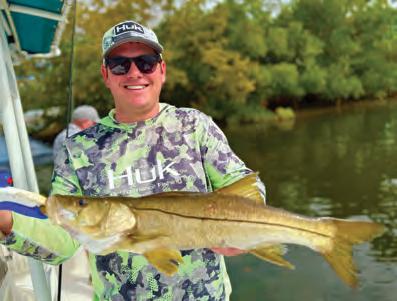
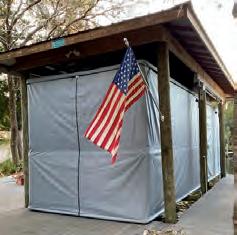


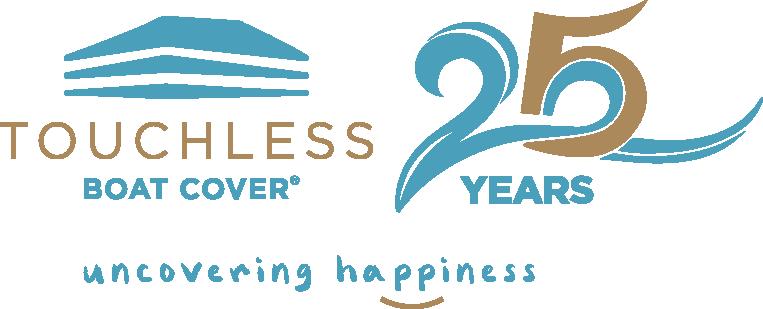
— Capt. George Hastick of “Fish Hunter Fishing Charters” in St. Petersburg, Fl. is the co-host of Florida West Coast Fishing Report and co-hosts Fishing Adventures Florida which is on five streaming channels and You Tube. He has been fishing the waters of the Tampa Bay area for over 40 years and guiding over 20 years.
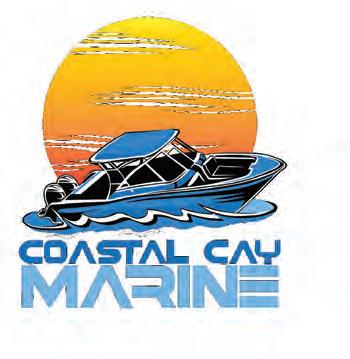


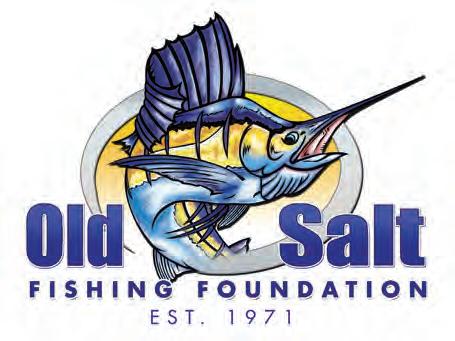
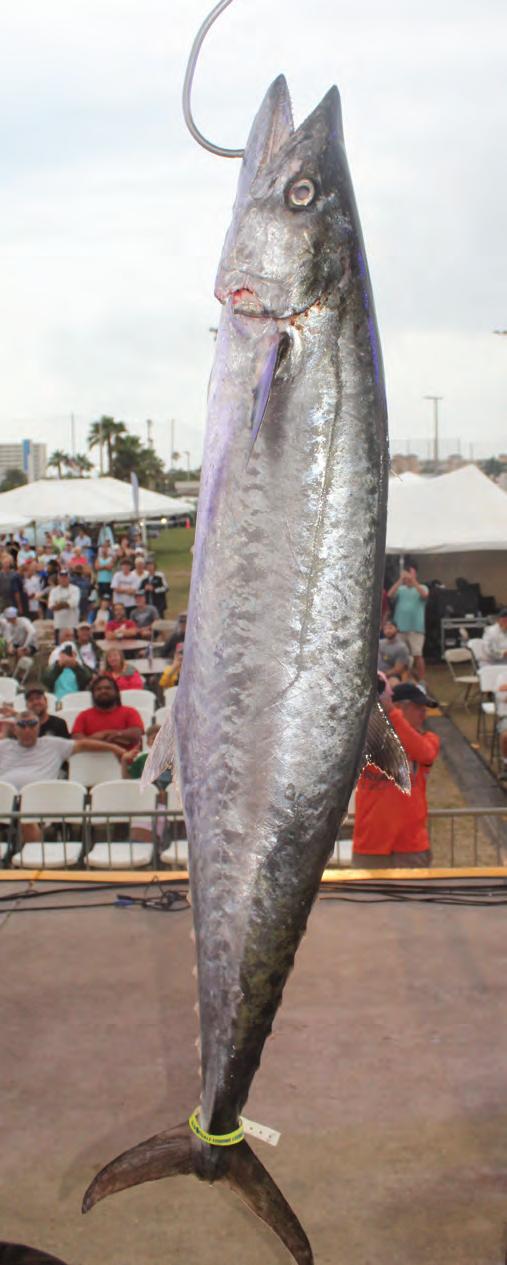
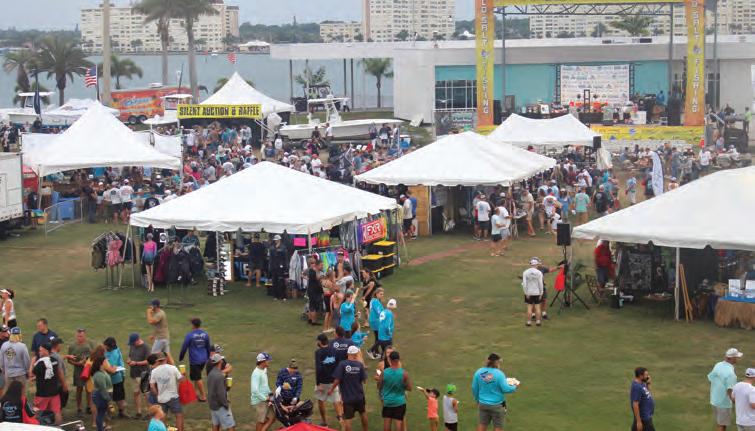
April 25 – 27, 2024
Have you ever tournament fished? If you have, then you know what the “King of the Beach” is and, if you haven’t and always wanted to, it is the best tournament in town.

This Spring, we are celebrating our 31st annual tournament and we are keeping it exciting with more ways to win and our Free Kids Sea Wall Tournament on Friday night. New this year is a giant new prize--an Owen & Sons Aluminum Slide On Trailer with 10,000lb capacity valued at $10,200 for the fish weighed in closest to 20.24lbs. This prize can be won by any team.
There are 3 main reasons to fish the King;
• LEVEL PLAYING FIELD: The Old Salts have made the competition one of the most fair for ALL levels of fisherman. They implement a 30-mile boundary to ensure any size boat can compete. They also offer extra places to single engine vessels. There are also no intimidating check outs or shotgun starts.
• OVER 60 PLACES TO WIN: The tournament has 6 divisions: Overall, Single Engine, Spanish Mackerel, Traveling Angler, Ladies and Youth. Each division has cash and/or prizes with approximately $250,000 up for grabs. Our single engine division 1st place prize is a new 200hp Suzuki complete with the repower package valued at over $19,826.
• LOW ENTRY FEES: You can enter the tournament for as little as $300, which is almost half the cost of most Kingfish tournaments. So, the risk is smaller and, at the same time, the rewards are bigger. First place overall wins $60,000 guaranteed.
The event is so much more than just fishing. It is a 3-day festival with all types of marine related art & craft vendors, a food festival with local flavor, Friday night is Community Night with a free Kids Fishing Slam and live music. “Combining a community food festival and live music into our tournament seemed natural to us, and fishing is part of our community, so we welcome all to join us,” says Old Salt President Tom Verdensky.
The Kids Seawall Tournament is Friday night. We will have all hands on deck to help the kids fish and measure their catches. We have prizes for each age group, and everyone has a chance to win in our Kids Only Raffle. The first 250 to sign up will get a free Rod/Reel combo.
The event will be held at the Madeira Beach Recreation Complex at 200 Rex Place, Madeira Beach. Make sure you visit our website for the latest updates on the tournament from hot fishing spots to places to stay with boat slips.
The Old Salt Fishing Foundation hosts this semi-annual event to benefit several local charities. This Spring, we will be presenting checks to P.A.R.C., Celma Mastry Ovarian Cancer Foundation and our very own Youth Summer Camp Programs.
To find out more information or to register for the tournament, go to www.OldSaltFishing.org, email amy@OldSaltFishing.org or call 727-216-6601.
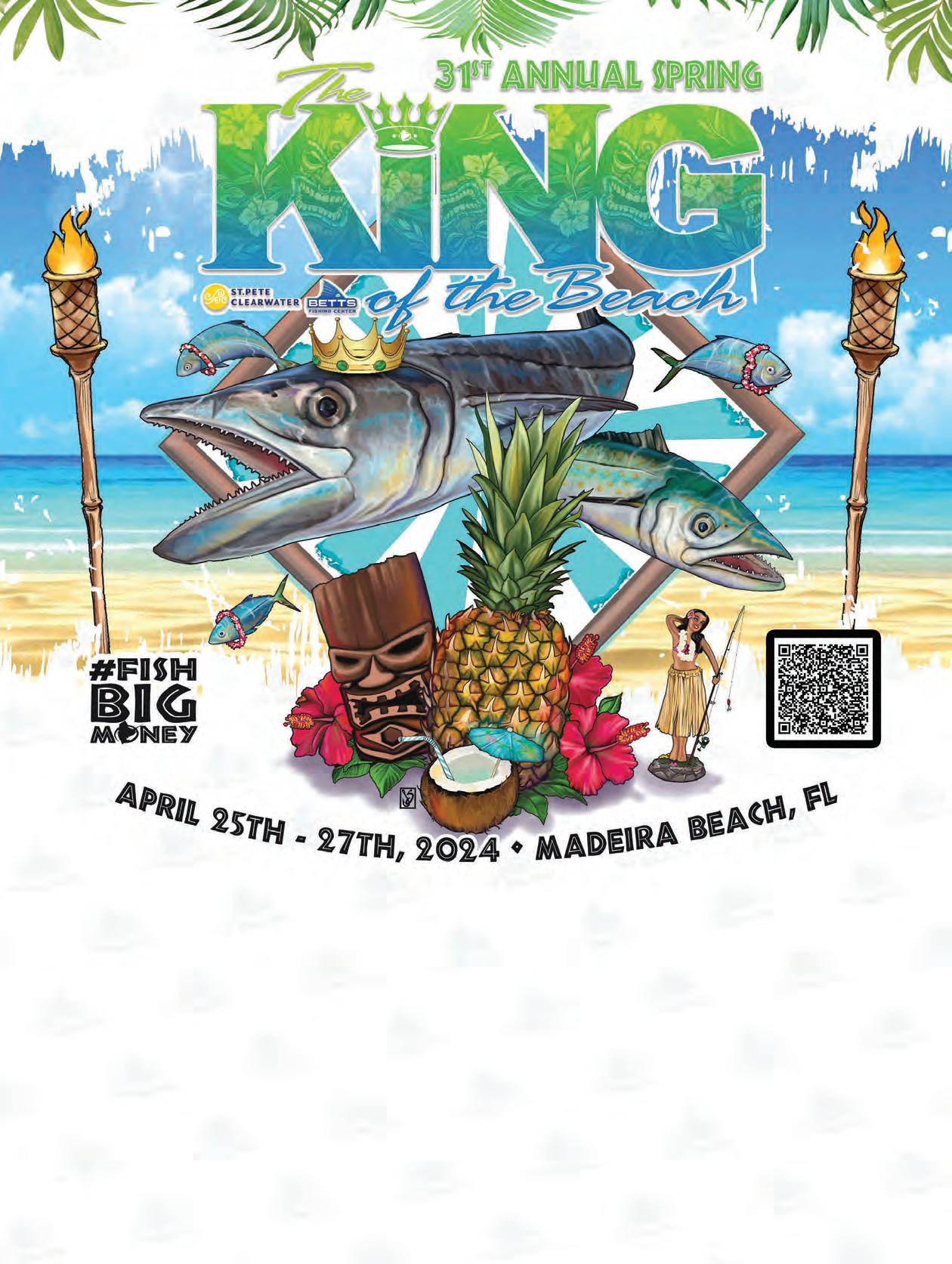





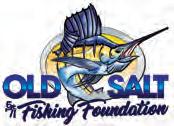






Instructions:
Ingredients:
• 2 cans chopped clams or 2 dozen fresh clams rinsed
• 2 tablespoons of clam juice
• I bunch of asparagus - just the tips
• I bunch parsley -1/4 cup chopped
• 5 cloves fresh garlic
• 1/2 stick of Kerry gold garlic and parsley butter
• 1/2 cup cooking wine or I just use our house Chardonnay
• 1 box linguine
• 2 tablespoons olive oil
Start the water boiling for pasta. If you use canned clams open them and rinse thoroughly, if not rinse whole clams.
Place olive oil and butter in pan. Add fresh garlic and cook until tender and aromatic. Add clams and asparagus.
Throw the pasta in the water. Stir the clam mixture slowly and place on low. If you use whole clams cover and let simmer for about 6 to 7 minutes so they open. Any that do not open should be discarded.
As soon as the pasta is done, drain. Add the clam sauce mixture to the pasta Place parsley on top and enjoy.
My husband loves this one.







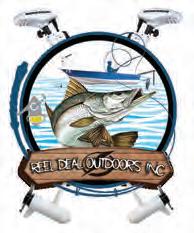

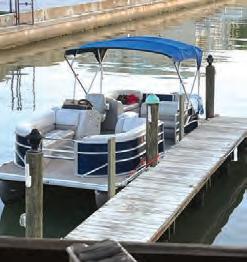
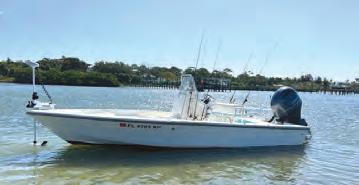

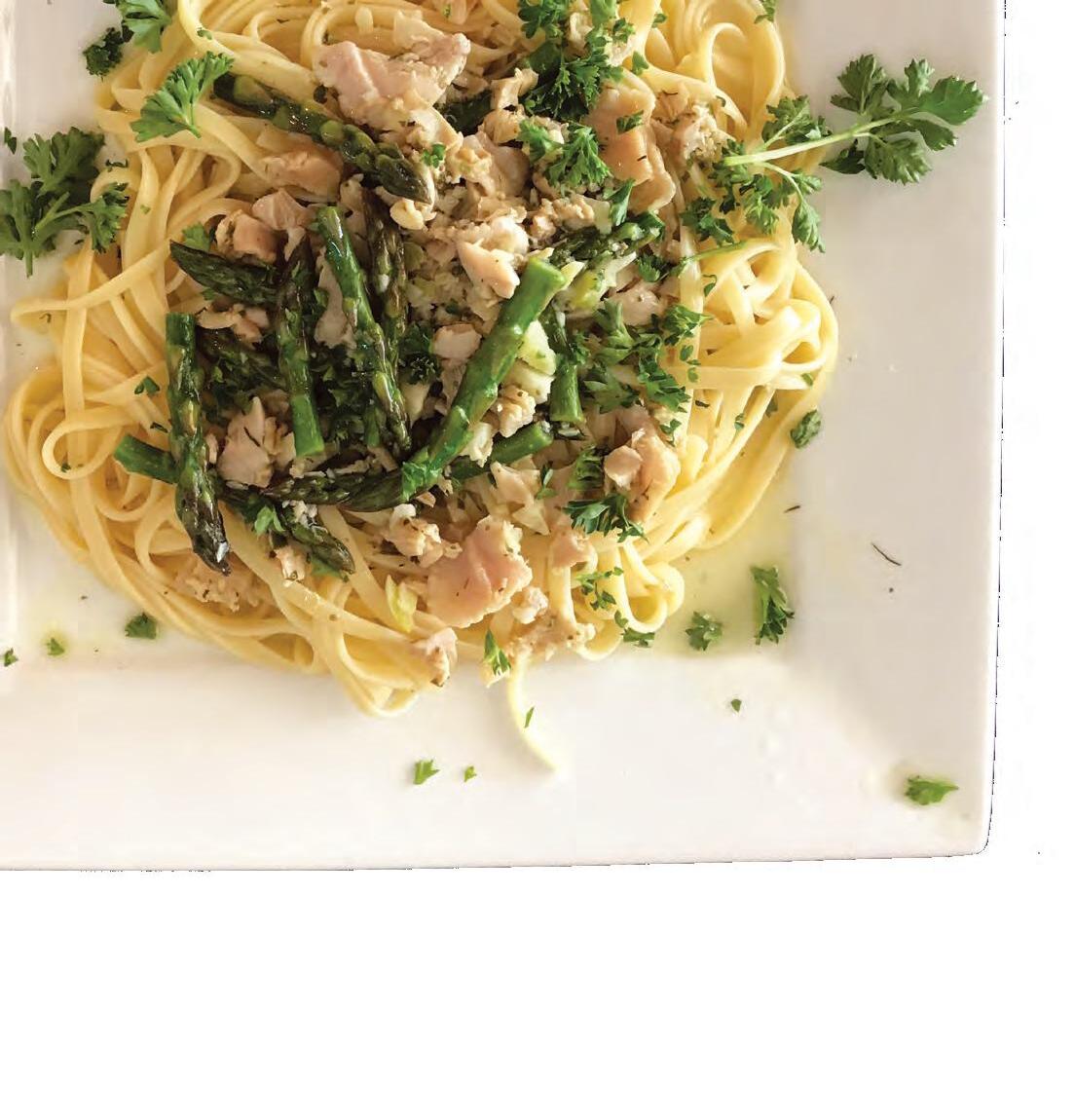



At last, April is upon us and with it comes some of the best fishing Tampa Bay has to offer. Anglers from Double Branch in the North to Bishop Harbor in the South are treated to some of the best inshore fishing anywhere in the State. Snook start their migration from the creeks and rivers to the flats and eventually to the passes to spawn by the first full moon of May.
Redfish and trout that call the flats home all Summer long, start bulking up on the greenback sardines. This live bait treat starts the ball rolling in the Spring and lasts until the first cold snap in the Fall. So, look for the bait along the mangroves and, not far from there, you’ll find the fish.
Look for mangrove snapper around rock piles and under the bridges. The best baits will be medium live shrimp or small greenback sardines. I started using a Yellowtail jig, new in this area but very popular down South and in the Keys. It’s nothing more than a 1/0 hook with 1/8 or 1/16-ounce weight on the shank of the hook. It comes in four different colors--super for catching mangroves and flounder.
Tripletails are number 10 on my food scale for taste and the same goes for a tough fighting fish. Live shrimp works wonders on these guys. Freeline them around crab trap buoys or range markers. They do spook easily, so keep your distance and let the bait drift around the buoys. Sometimes it takes more than one presentation for them to take the bait.
Spanish mackerel and cobia also follow the bait inside the Skyway Bridge. The bigger baits will hang around tripods, artificial reefs and rocky bottoms

that abound from channel A just inside the Skyway Bridge to the Howard Franklin Bridge to the North.
I find Spanish mackerel fishing exciting and most productive for my clients. I make it a point to start my morning by searching for a school of big mackerel to get the adrenalin going. After boating 20 or 30 mackerel, it’s time to move on and start another hunt.
My method for fishing Spanish mackerel is very simple. Find the bait, anchor up and start a chum line to keep the mackerel feeding behind the boat. Cut greenbacks will work great. A 5-pound box of frozen chum also does the trick. Using light action tackle such as a 7.5-foot rod, 3000 spinning reel with plenty of 15-pound test braided line, and a #1/0 XX long shank hook with 30-pound test fluorocarbon leader about 32 inches long works well. The XX long hook eliminates the need to use wire leader and increases your bites.
Hillsborough County has six artificial reefs that produce great quantities of Spanish mackerel every year. The information with GPS location can be obtained from the Florida Fish and Wildlife Conservation Commission, and they can even mail you their brochure upon request.
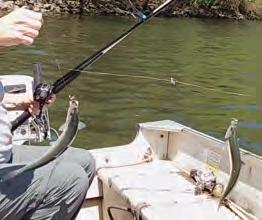
If you have kids, mackerel can entertain them all morning long. Also, remember that redfish and snook are great to catch, but sometimes hard to find and slow to bite. Make this April a family affair with the kids by putting them on some fast mackerel action.
Greenback sardines are the best bait for mackerel. I prefer catching the bait. It’s part of the fishing trip or, as I like to say, “making it an adventure for my clients as they are watching how it’s done.” There are three basic ways to catch bait, using the traditional 10-foot bait cast net, BallyHoop Net or the WhyTangle Hook Tunnel for use with a Sabiki rig. If you can’t throw a net or have a bad back, the last two mentions are a great substitute and well worth the investment in the long run.

— Capt. Sergio Atanes is host of Florida West Coast Fishing Report on Facebook and YouTube. He also hosts Fishing Adventures Florida TV show airing on YouTube, Waypoint TV, Carbon TV, Outdoor Action, and Angling TV. Owner of Reelfishy.com Charter business covering the west coast of Florida with over 135 captains on staff.
For information contact Capt. Sergio at (813) 973-7132 email: atanes@msn.com.


Continued from page 1

why, many times, I’ll start out fishing around some sandy potholes on the grass flats trying to catch the seatrout first. If I have no success, I’ll move on to snook and redfish and come back to seatrout to close the deal.
While in pursuit, here’s where you should be looking for that snook and redfish. With water temperatures back in the low 70s snook are moving out of the back bays, creeks, and rivers and seeking shelter along the mangrove shorelines and points. Snook feed best on a good tidal flow. Some days, it may vary whether they prefer an incoming or outgoing. So, just make sure the current is moving.
To get the action going, toss out a few live scaled sardines and wait for the snook to respond by attacking the freebies. Once they start feeding, cast a hooked live sardine to the same spot for an instant hook up. If you get lucky, you’ll be able to catch numerous snook in the same spot and also land one over 28 inches. If you do catch a big one at your first spot, move down the shoreline a hundred yards or so and try again.
If you’re fishing during an incoming tide and it’s reaching its peak, move on to redfish. Redfish like to feed on crustaceans around oyster beds and barnacle encrusted mangrove roots during a high tide. Find a spot with both, and you’ve found a redfish goldmine. Redfish also like to travel with mullet. The reason, mullet flush baitfish and crustaceans out of the grass as they feed. Anytime I spot a school of mullet, I get out in front of them and Power Pole down.
In either scenario, always start by chumming with scaled sardines. After
that, cast a bait out that’s suspended under a cork. Once the cork goes under, give the fish 2 to 3 seconds to eat the bait, then when you reel and get your line tight, lift your rod for a solid hook set.
Let’s say after a day on the water you caught all three inshore slam species, but they weren’t all big fish. You still achieved a slam, just not an official inshore slam. There’s always next time.
Tarpon and Spanish mackerel will be migrating to the Tampa Bay as we approach-April. Tarpon start showing up first around the Sunshine Skyway Bridge and the Port of Manatee. One of the best fishing technics to use around the bridge is to Spot Lock or anchor your boat between the pilings and start a fresh cut bait slick. Once you have a slick established, start freelining hooked live bait within the slick. If you’re fishing at the port, do more of a spot and stalk, or just drift fish past the schools.
Spanish mackerel make their presence at the mouth of Tampa Bay and slowly end up all the way past the Countney Campbell Causeway. Early on, you mainly catch them around the bridges, artificial reefs, and range markers. As time goes on, Spanish mackerel start moving onto the grass flats as they feed on baitfish. There have been times when I’ve caught them in as little as two feet of water.
Some people claim Spanish mackerel aren’t good table fare. Not true. The key to good fillets is to ice the fish down immediately, and always cut the bloodline out when filleting.
Afishionado, “Always an Adventure.”
Tampa fishing guide, Wade Osborne of “Afishionado Guide Services” has been plying the waters of Tampa Bay as a professional full-time captain, since 1997. Osborne has been featured on numerous TV shows and has written for multiple publications. Osborne offers multi-boat, corporate and private inshore fishing on light tackle spin, fly or plug. He also offers eco tours with an emphasis on photography. For more info visit Afishionado.com or find Afishionado Guide Services on Facebook and Instagram.
Email: wade@afishionado.com Call/Text: 813-286-3474

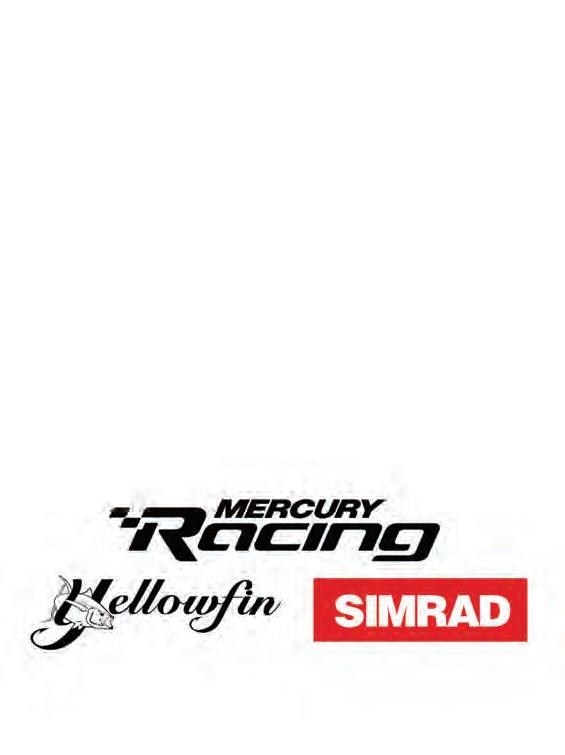

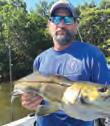

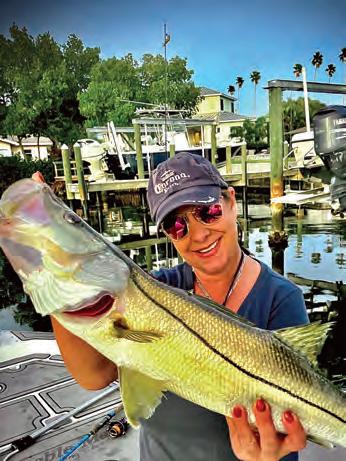
Temps are slowly rising but dropping in a one-day cold front. One word that can define the bite right now, is FIRE!!! All baits are working. Artificial, cut and live all seem to be working. Multiple catches of Snook and Redfish over the Thirty-inch mark. Trout are active on the grass flats and still catching great numbers of sheepshead.
After spending most of last month finding fish, I have found three main areas to target. But keep in mind these fish like a different presentation. For dock Snook and Reds. Use live bait free lined. For channel fish try crabs and up in the trees a combination of live bait and cut bait has been deadly!!!
We are going to see our migrations start to move this month. Look for good tides and water temps in the 72-74 range. That is your magic number. Same gear that I always use. 2/0 demon perfect circle on 15lb braid and 20lb leader.
For new fisherman trying to start into the fishing hobby I recommend two bait shops in the St. Pete area. Mitch’s Bait and tackle on 4th Street and Dogfish Tackle and Marine in Pinellas Park. Two great shops with all the gear you would ever need. Mitch’s Bait and Tackle has all live bait needs and equipment and very Knowledgeable. For Dogfish tackle and marine has all your offshore and inshore needs covered.
The bite is definitely hot right now so get out there and put a line in the water!!!! Remember match the hatch and What makes you a better fisherman is putting in the time! Be safe have fun
— Capt. Mike Ayersman | Down Range Charters 863-812-7896 | downrangecharters.com

Tampa, FL – An innovative environmental restoration project - the Clams for Clean Water Initiative, has been unveiled with the ambitious goal of revitalizing the water quality and habitats of Old Tampa Bay.
Utilizing the natural biofiltration capabilities of bivalves, such as Eastern oysters and quahog clams, the initiative aims to enhance water quality by reducing nitrogen, phosphorus, and other pollutants. Strategically selected pilot sites along key areas, such as the SR 60/Courtney Campbell Causeway, will serve as the focal points for these efforts. This is expected to not only improve water clarity but also facilitate the growth and recovery of crucial seagrass habitats, further stabilizing the shoreline and enhancing biodiversity in the bay. By demonstrating the effectiveness of natural ecological processes for environmental restoration, the Clams for Clean Water Initiative offers a scalable model for conservation efforts not only in Tampa Bay but potentially in similar ecosystems along Florida’s Coasts.
A cornerstone of the Clams for Clean Water Initiative is its comprehensive research component, aimed at understanding the intricate relationships

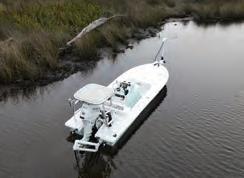
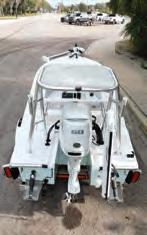

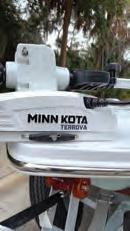
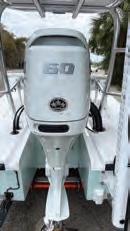
between bivalve filtration, water quality, and habitat improvement. Through applied research and monitoring, the project intends to offer valuable insights into the ecological and societal benefits of shellfish restoration.
Furthermore, the initiative places a strong emphasis on community engagement and education, striving to enhance public awareness of watershed issues and the critical role of bivalves in maintaining ecosystem health. Through targeted outreach efforts, the project seeks to foster a more informed and environmentally conscious community.
Salt Strong Alliance wants our communities and partners in conservation to see that we are not only passionate about fishing, but we are a true unified force to positively impact and protect our natural resources and fisheries for future generations. We believe in the importance of responsible and sustainable fishing practices, and we want to be a leading example of that in our communities.
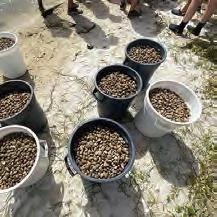
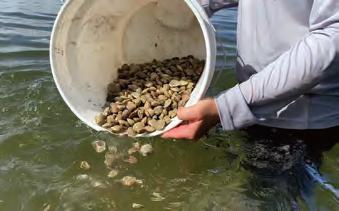

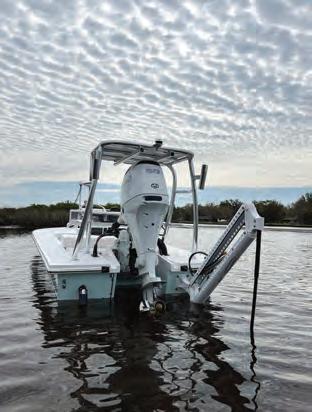

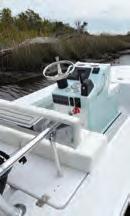
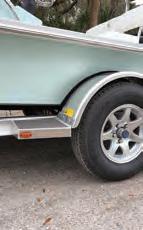

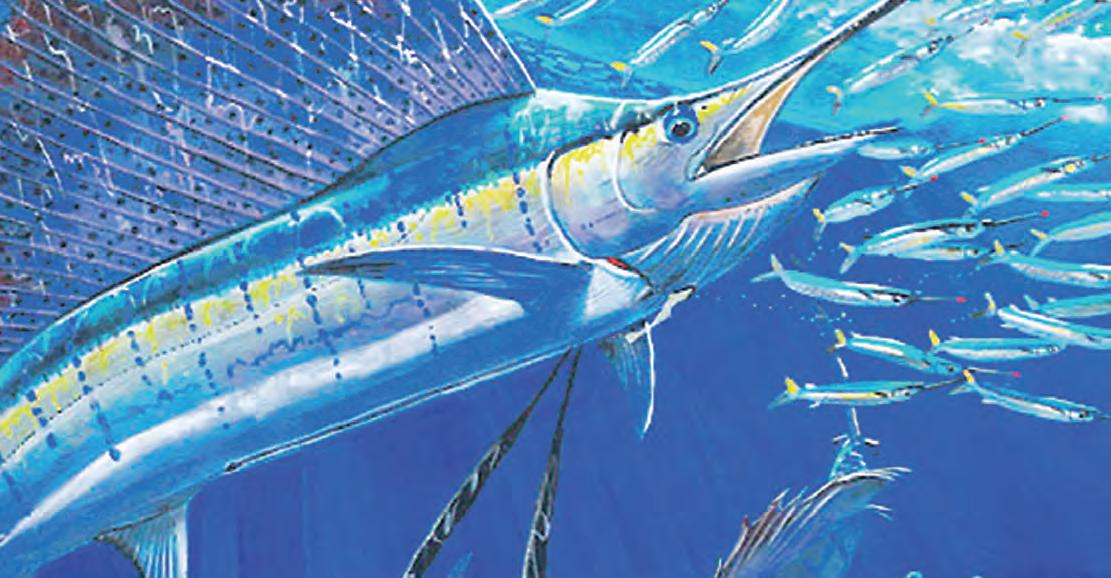

Fishing off St. Pete Beach in about 20 feet of water Christopher Pansa caught this 30-inch redfish on #1 circle hook with a shrimp.



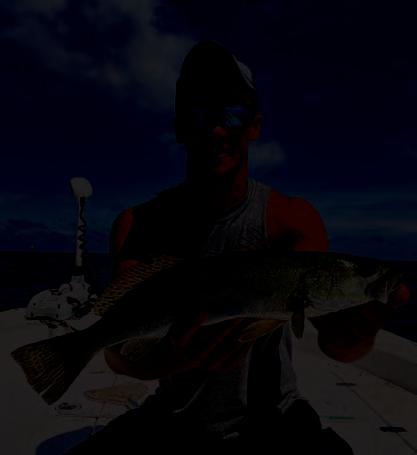
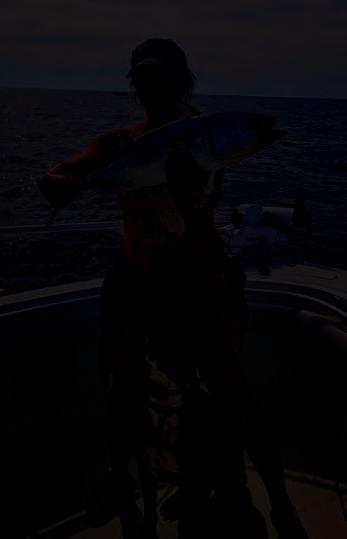
was about 24 inches, and a really fun fish to catch!

For a chance to be featured on the Brag Board, upload your high-quality photos (at least 1MB) along with all of the catch details at: COASTALANGLERMAG.COM



With 16-Inch & 12-Inch Heavy Duty Beach Wheels, Custom Axle Kits & Pompano Rigs!
16-INCH:
$129.99/Pair with Bushings
$169.99/Pair with Bearings
12-INCH:
$119.99/Pair w/Bushings

$159.99/Pair w/Bearings
• Fits 3/4 Axles
• 350 lb. Weight Capacity Per Pair
• Stainless Steel Needle Roller Bearings

We Sell 3/4 In. Solid Aluminum Axle Kits for $34.99!
The second season of the Florida Fish and Wildlife Conservation Commission’s Triple Treat Trowdown runs from March 1 to Sept. 29, and Triple Treat Club members have a chance to win an awesome fshing kayak bundle valued at more than $4,500.
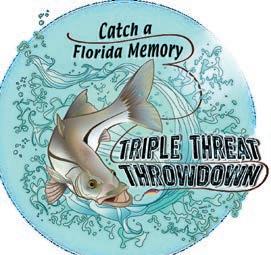

779.770.2100
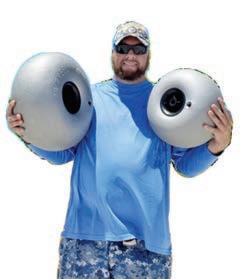




Te Trowdown is a part of FWC’s Catch a Florida Memory, which is intended to enhance and increase participation in saltwater fshing. Te Triple Treat Club is for anglers who have achieved all three of Catch a Florida Memory’s recognition programs: Saltwater Grand Slam, Saltwater Reel Big Fish and Saltwater Life List 10 Fish Club. Anglers who reach Triple Treat Club status will be entered into a drawing for the kayak bundle afer the Trowdown season ends on Sept. 29. Anglers who are already in the Triple Treat Club will receive a drawing entry for each new recognition they earn during the challenge period.
“Building of of last year’s successful season, we are excited to announce Season 2 of Catch a Florida Memory’s Triple Treat Trowdown with an even bigger prize from our generous sponsors,” said Jessica McCawley, director of Marine Fisheries Management. “We encourage anglers to get out on the water, make Florida memories and help conserve fsheries by targeting a diversity of species.”
One lucky angler will be randomly drawn to win a top-of-the-line kayak fshing bundle valued at over $4,500. Tis bundle includes a Bonafde P127 kayak, a premium Mustad fshing gear bundle and kayak safety kit. Te award is made possible by Bonafde, Mustad and Russ Vorhis Insurance AgencyState Farm.
Find out how to qualify for the drawing at CatchaFloridaMemory.com.
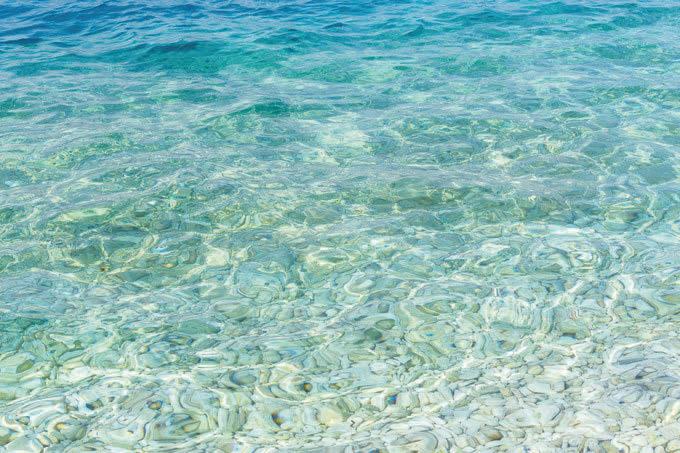




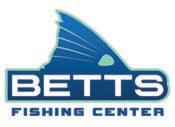

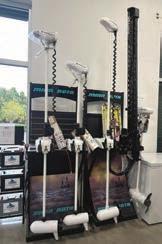
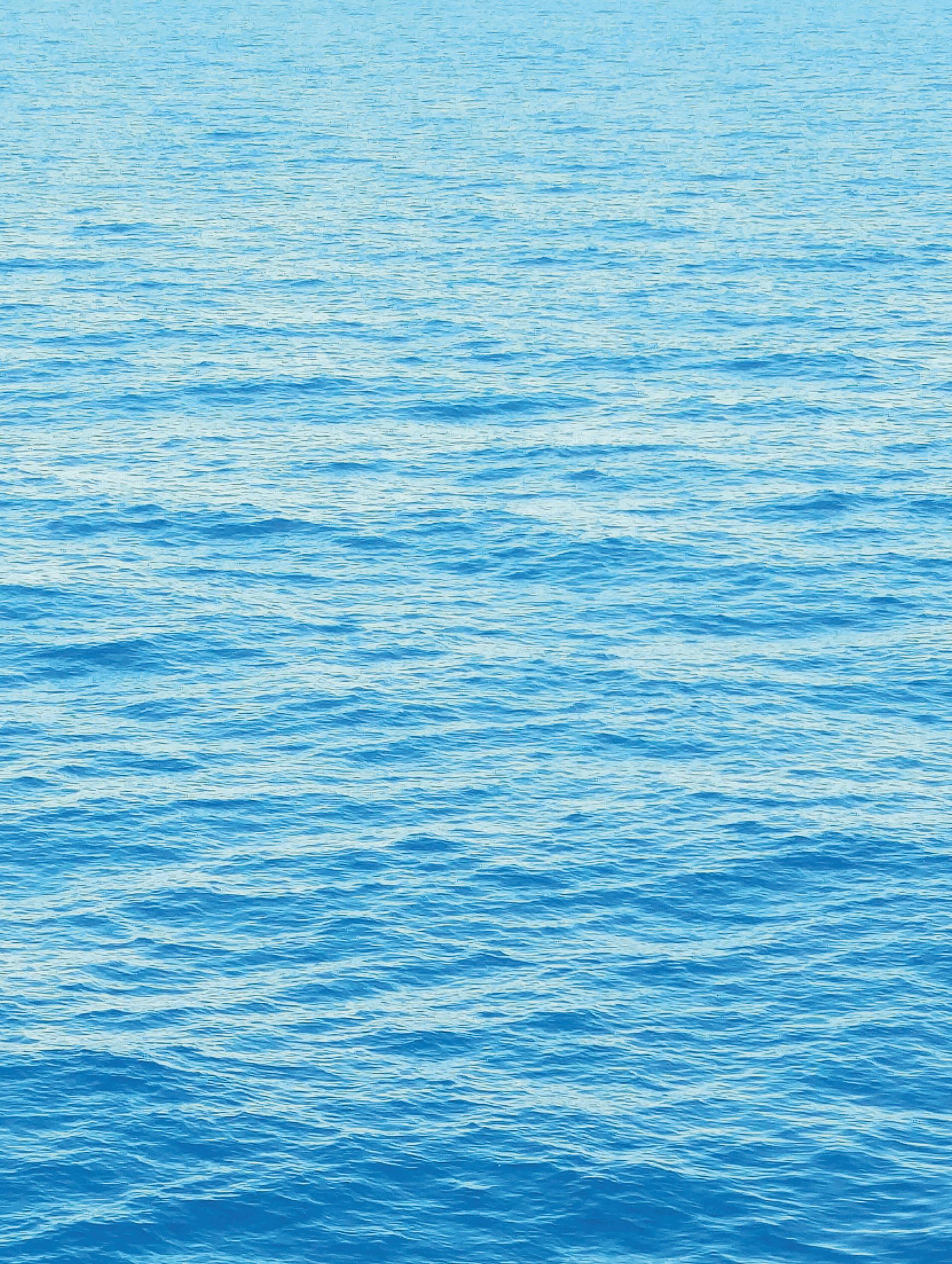
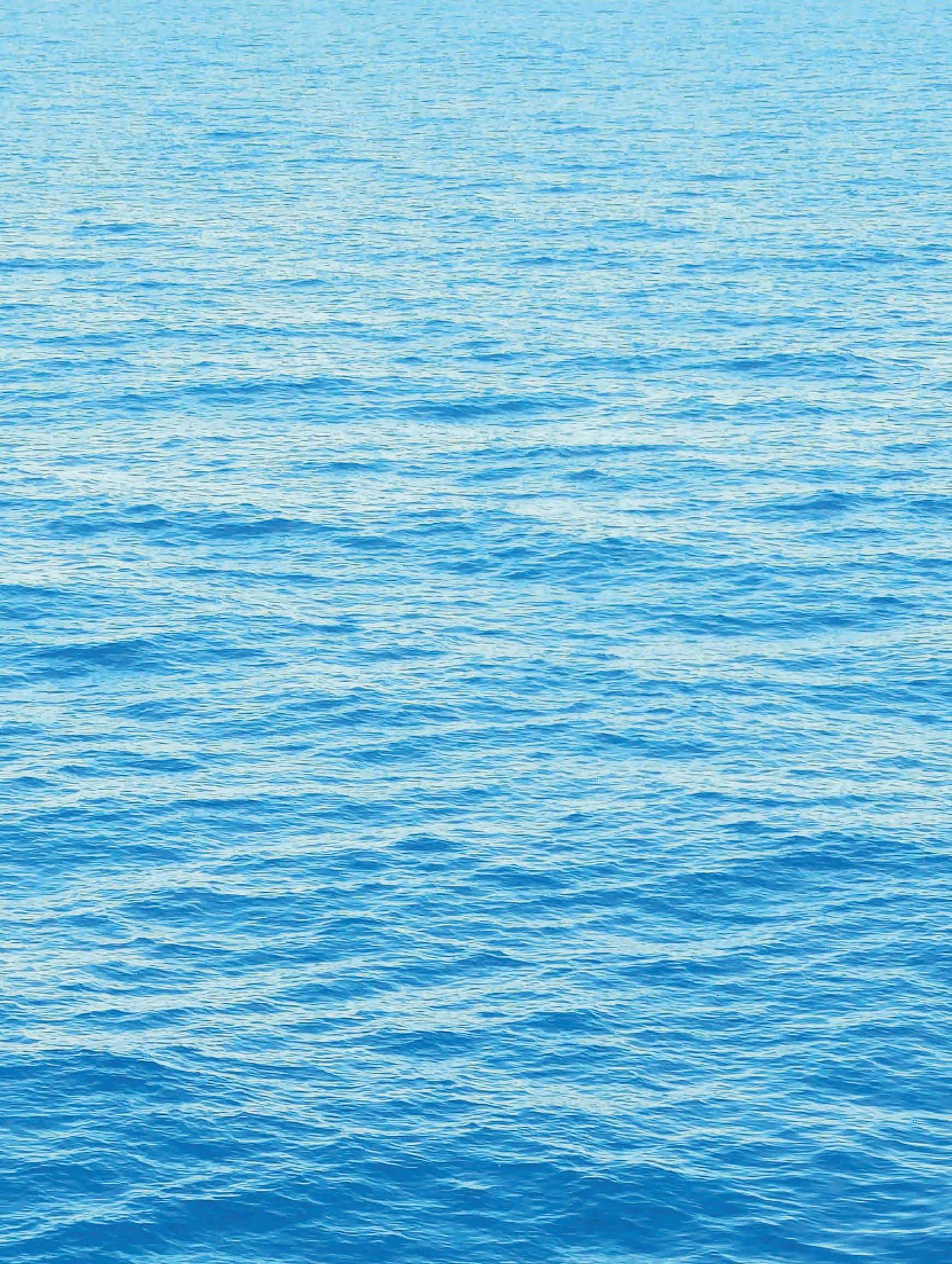


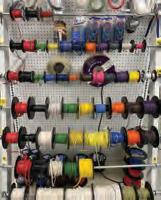
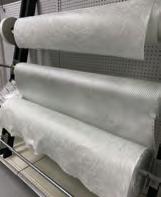
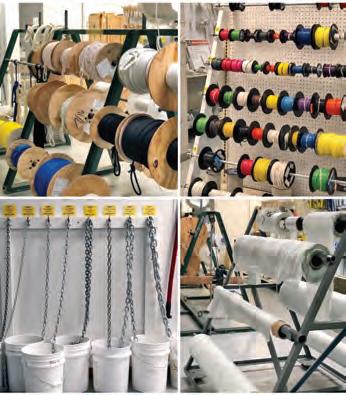
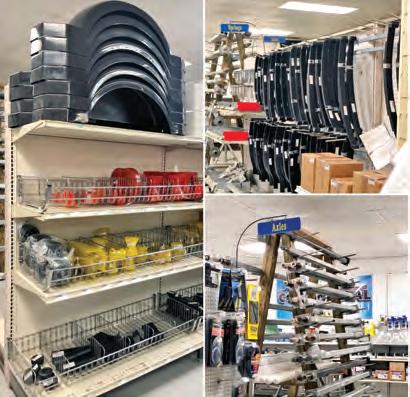




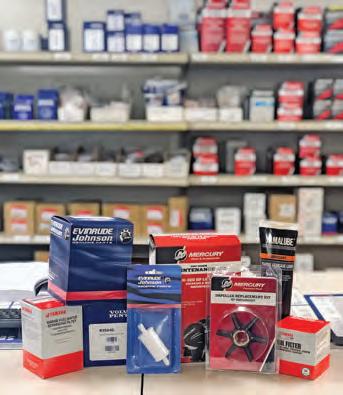








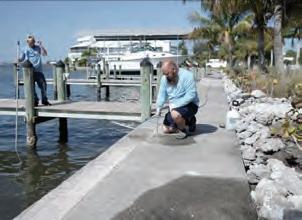
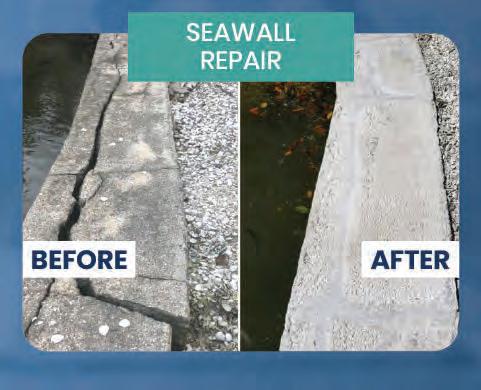



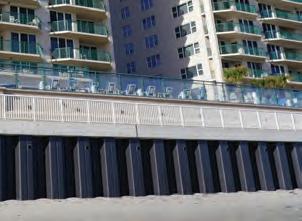
1.
2.
3.
4.
5.


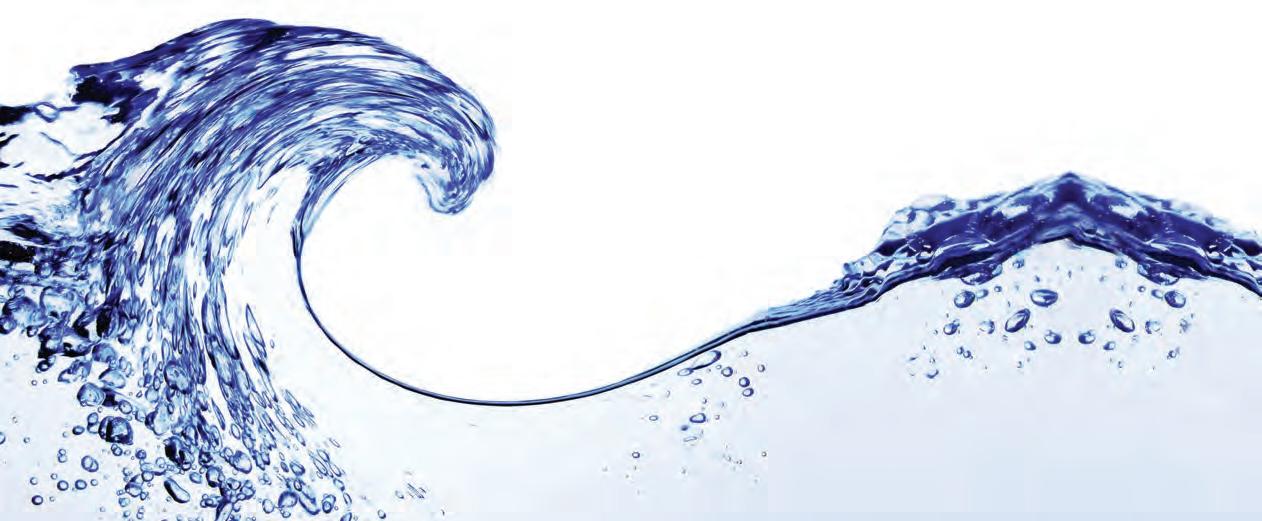



SPRING fiSHING CLASSIC EVENT SAVE UP TO $4,000
SPRING fiSHING CLASSIC EVENT SAVE UP TO $4,000




ENDS MARCH 27TH, 2024
ENDS MARCH 27TH, 2024
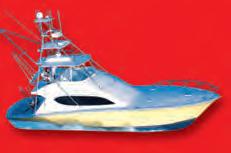
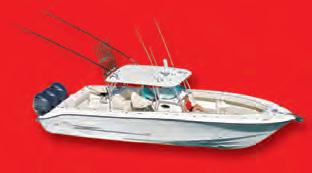


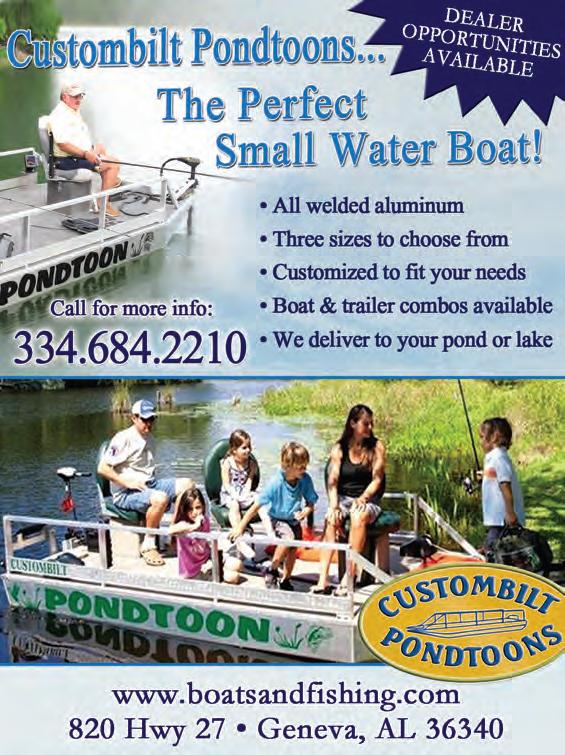


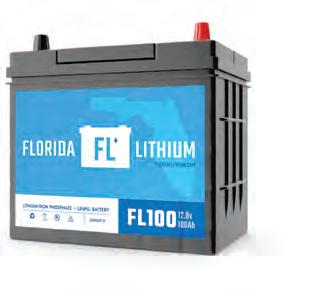
While working for his father’s transformer company, Deltona Transformers, in the 80s, Mike Prelec Sr. identifed an opportunity to provide a smarter battery charging solution to the bass fshing industry. Subsequently, Mike Sr. and the engineers at Deltran designed and built the global brand Deltran BatteryTender®, a leader in battery chargers and accessories.
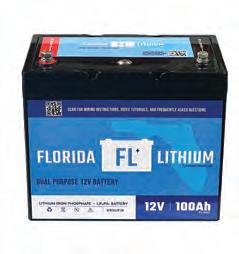

Fast forward 40 years, and Mike Sr. parlayed his experience with electronics to test and scrutinize a new generation of high-quality, fast-charging lithium batteries. Mike established a central Florida test lab and began ordering samples from several overseas manufacturers. Even the platinumtier manufacturers provided varying quality in components, cells, boards and overall inconsistent construction. Several years later, with a select group of top-tier vendors, Florida Lithium was launched to provide bestin-class deep cycle-dual purpose (800 cranking amps) LifePO4 batteries that meet or exceed all Mercury requirements for lithium batteries. Today, Florida Lithium’s product line ranges from 12V, 36V and 48V batteries, providing versatile options for cranking, house electronics, or trolling motor applications. Teir DeLand warehouse is available for pickups Monday through Friday (by appointment only), and they ofer shipping nationwide. Florida Lithium also provides batteries and accessories to marine dealers, boat builders and marine service/repair shops throughout the Southeast.
Tere is no doubt you can fnd cheap lithium batteries on Amazon or other marketplaces, but when push comes to shove, some of those poorly constructed batteries will fail, leaving you with a very expensive paperweight and the inability to get anyone (stateside) on the phone. Florida Lithium’s customer support team actually speaks English, and in the event you reach their voicemail, a member of the team will respond in a timely manner.
Florida Lithium is proud to provide Florida-based customer service and technical support, coupled with a no-nonsense fx, repair or replace warranty. Lead-acid batteries are quickly becoming a thing of the past. If you are looking for a powerful, lightweight and reliable battery upgrade, Florida Lithium has you covered. Teir team is made up of Florida-based boaters and fsherman, and they understand what’s required to maximize your on-the-water experience.


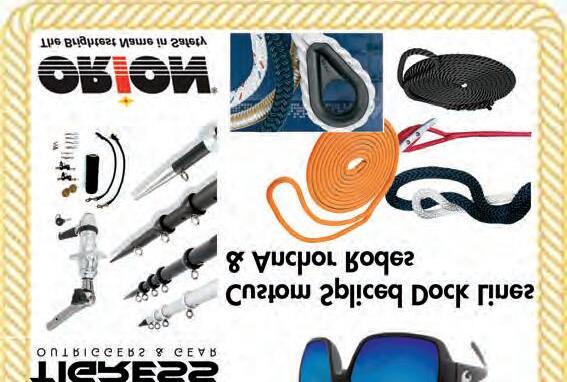



 By Scott Goodman
By Scott Goodman




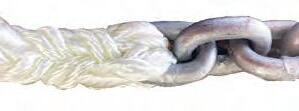

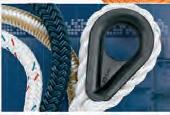
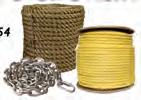
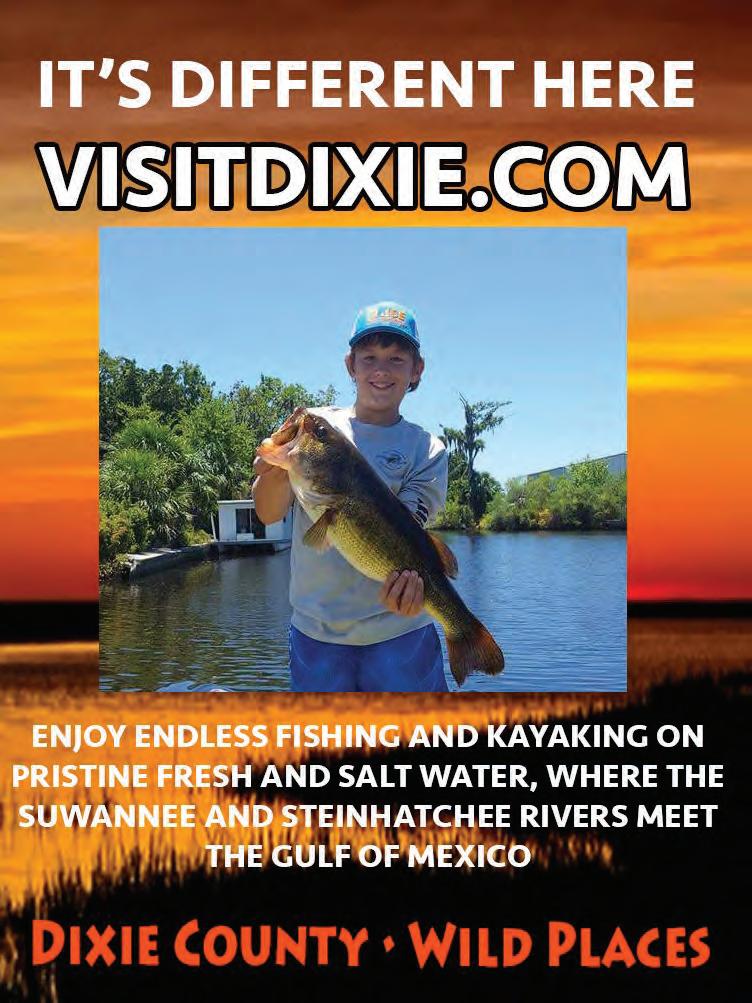
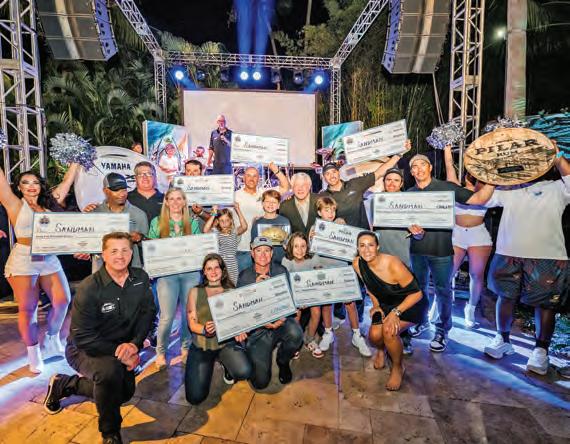
Jimmy Johnson’s Quest for the Ring Championship Fishing Week is an annual South Florida event that is renowned for a guaranteed milliondollar-plus purse. It’s the largest guaranteed prize for fshing in the world, so far as we are aware. Te “real prize” is the chance for one team to win diamond-studded Super Bowl-caliber rings that rival any awarded by the NFL.
Te event’s namesake is, of course, legendary Hall of Fame football coach Jimmy Johnson, who is now a fxture in the South Florida fshing community. I had a chance to sit down with Coach to pick his brain about the tournament.
Johnson grew up on the Gulf Coast of Texas and loved saltwater from the get-go. “Daddy had a little14 foot wooden boat in Galveston,” he recalled. Johnson fshed as a child and developed a passion during his time as head coach of the Dallas Cowboys.
“I liked to get out in the boat early and fsh by myself,” he said. “I found fshing to be so peaceful as opposed to the stress of coaching pro football. I just love it. I have caught and released fve blue marlin by myself… but my favorite fsh is the wahoo because they just scream. I’ll fast troll with lures or slow troll with a ballyhoo and a cigar weight.”
Coach Johnson’s tournament started as a local Florida Keys event.
“Well, it started as a small tournament in the Keys centered around my restaurant, Jimmy Johnson’s Big Chill,” he said. “Since bringing on the crew at Fish Hard Events, it has become the enormous experience it is today.”
Jimmy Johnson’s Quest for the Ring Championship Fishing Week, or JJFISHWEEK, includes the main event, the two-day Catch & Release ‘Quest for the Ring’ Championship, featuring a $1 million guaranteed purse; JJ’s National Sportfsh Tournament, for the meat fsh afcionados; and the inviteonly Hard Rock Invitational.
Tis year’s JJFISHWEEK concluded March 9 with an awards ceremony at Seminole Hard Rock Hotel & Casino in Hollywood, Fla. Coveted championship rings were awarded to Owner Sandra MacMillan, Capt. John Louis Dudas and Team Sandman, aboard a 63-foot Spencer, which earned them a cool $300,000. Tis marks Sandman’s third championship, having clinched the title in 2018 and 2020.
Obviously, the money and fshing are big-time, but Johnson likes how the event engages the fshing community and gives back. Tis year’s event raised more than $100,000 for the CI Foundation, which will be gifed to its charitable benefciaries.
“I love the people that it brings together,” he said. “We also have a number of charities that we support. My son has the Tranquil Shores Foundation, which is a drug and alcohol abuse center. He’s got a foundation for people who can’t aford treatment.”
Te next stop for Jimmy Johnson’s Quest for the Ring is an inaugural Atlantic City, New Jersey tournament July 14-20. Next year’s Florida event is slated for March 4-8, 2025. For more information JJFishWeek.com.
Scott Goodman is Co-publisher of Coastal Angler Magazine/Miami.

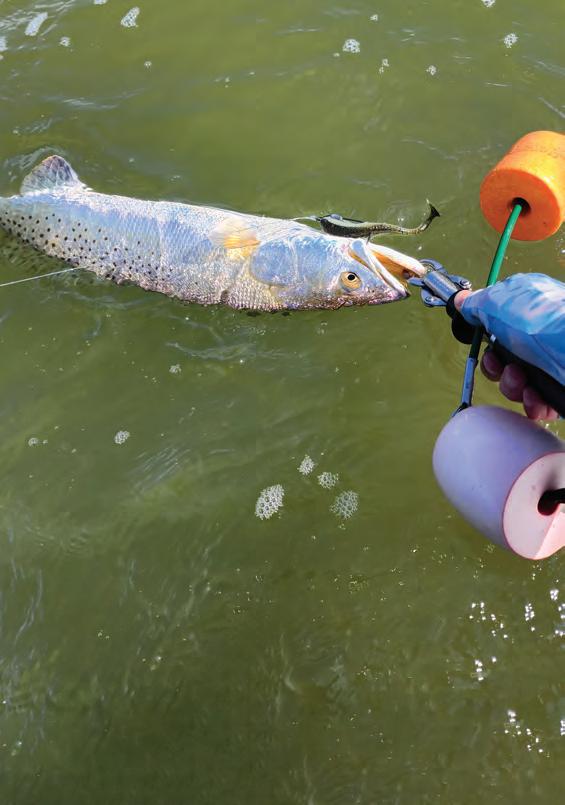
As the seasons change, so should your fshing locations and tactics. In my quest to target larger trout and reds, I modify my approach slightly versus what I have been doing for the past three or four months. However, depending on the weather, spring can be a tricky time to fnd solid and repeatable patterns. With the water temperature swings, the fsh begin to move from winter to spring areas. But a slight cold front will send them right back to their winter patterns, and it will keep you on your toes.
Te frst major transition is from mud to a frmer sand bottom. In my area, the prominent structure will still be grass, but the base sediment will change. If your area structure is shell or rocks, you will still want to fnd harder sand. According to biologists, the primary reason for this is the winter forage, primarily mullet, fnd their food source in the mud during the colder months. We all know fsh follow the bait, and that is why we target trout and reds on sofer bottoms in the winter. As the water warms, the next generation of perch shrimp and other species hatch and will be found in structure with a frm bottom. In my area, that will be grass.
Now that we know where to fsh, let’s cover the how. In spring, staying tight to the cover is important. It is imperative for juvenile forage to stay in tight schools and intermingled in the structure for survival. Keeping your lure near the grass, shell, or wherever you are fshing will be critical to success. I target the borders where sand and grass meet. Each area will vary depending on if it is predominantly sand or grass. If it is mostly grass, I concentrate my eforts casting into the grass and working my lure into the sand, paying attention to the edge and giving the fsh time to fnd my lure at that intersection. On the other hand, if it is mostly sand, I will target the grass patches and once again the edge.
Spring allows us to utilize a wide range of lures. Sof plastics danced along the bottom or topwaters skated across the surface can both be efective, depending on the mood of the fsh. Tis will be determined by water temp and the passing of late-season cool fronts.
Whatever lure you decide to use, concentrate on the edges of the available cover to increase your odds of having a productive day. As always, take a kid fshing; you just might learn something.
Capt. Michael Okruhlik is the inventor of Knockin Tail Lures®, and the owner of www.MyCoastOutdoors.com.
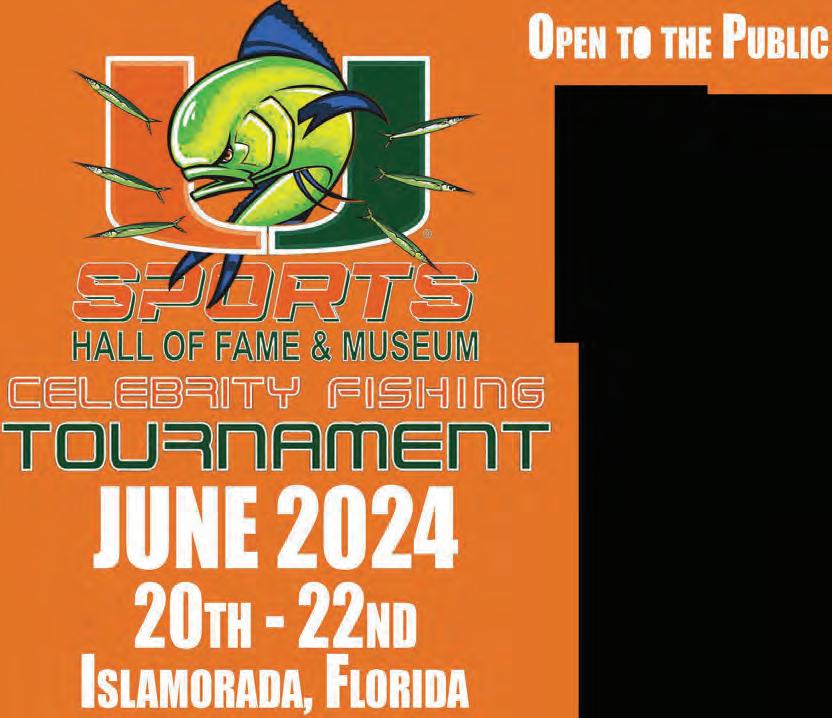




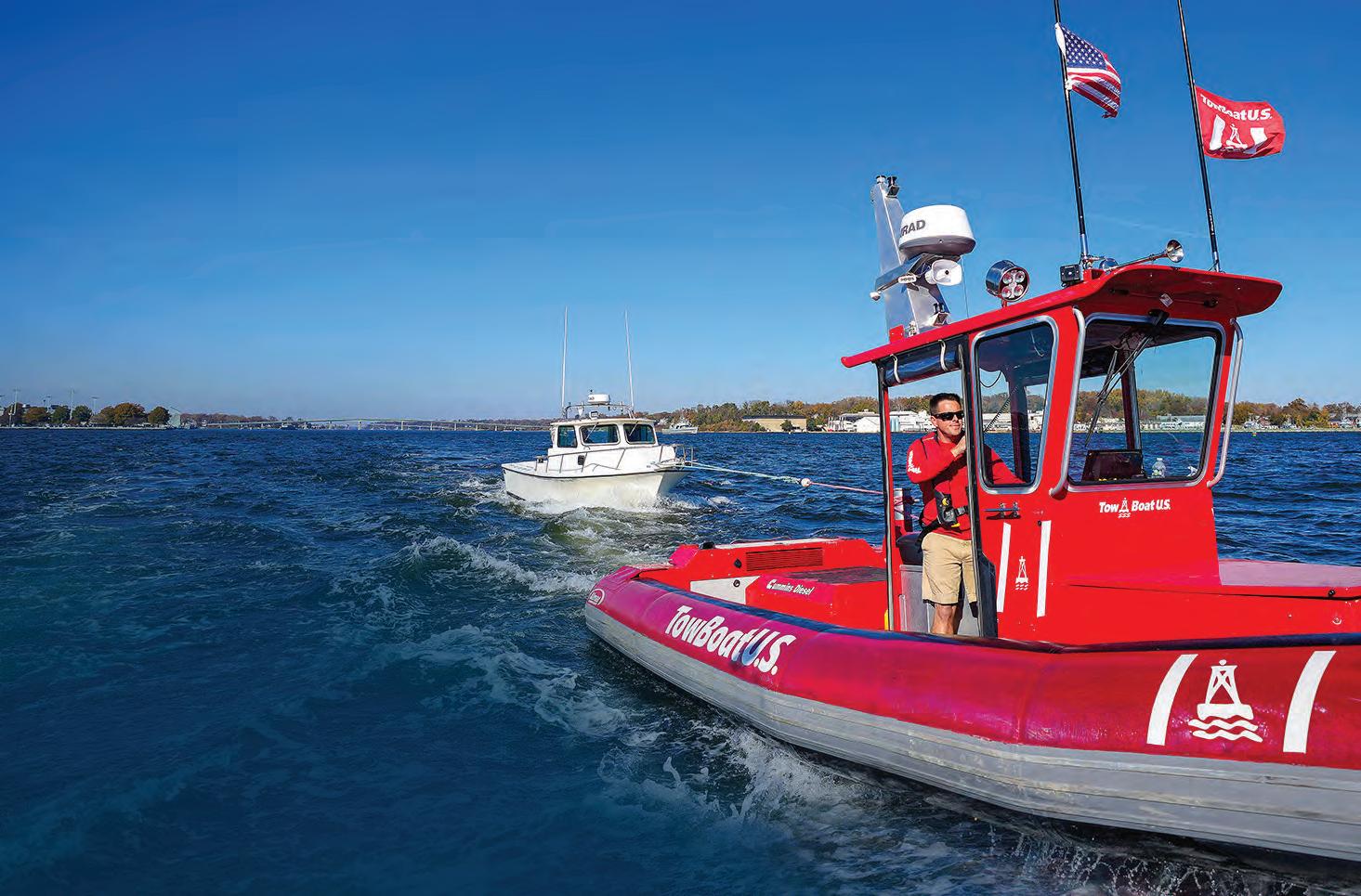
Spring is one of my favorite times of year for many species on the inshore menu, including red drum, snook and trout. I usually fsh at night for several reasons including my “day job,” which keeps me occupied for a vast majority of daylight hours. I guess I could become a weekend warrior, but I’ve noticed the best weather typically doesn’t occur on weekends. Tere’s an old saying that goes something like this: “You know what happens afer two days of really crappy weather?”
“MONDAY!”
All joking aside, I believe the best bite for older, wiser, heavily pressured fsh is at night. Tey’re a little more at ease afer the sun goes down and the boat trafc lets up. Tis is when the big girls let their guard down and come back into shallower water to feed. Wherever you fnd shrimp and small mullet along the edges is a good place to take advantage of aggressively feeding redfsh, trout or snook afer dark. Te patterns are similar for all of them.
Just before dark is a good time to get situated to the rising or falling tide and the water clarity, which might be afected by

frequent rains this time of year. Get used to your surroundings and how fast the current is running. Keep the lights low, and allow your night vision to kick in as darkness settles.
Music on the boat is fun, but this is a situation when you’ll want to be quiet. Don’t play the radio loud or stomp around on the deck. Close your coolers and hatches quietly. Try not to talk are laugh too loud. Sound travels extremely well in the water, and when the rest of the world is quiet, the noise you make is even more startling to the fsh.
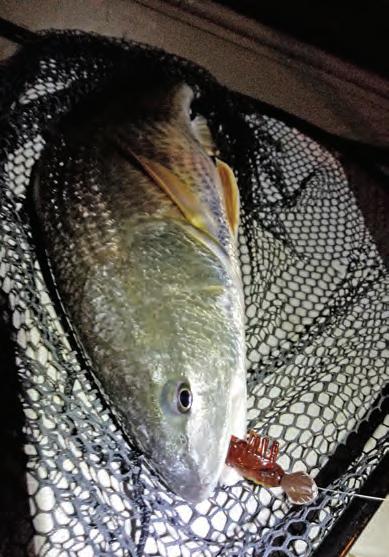
I don’t even use “spot lock” on the trolling motor at night in shallow water. I think fsh have learned to associate the sound of trolling motors with the presence of a boats and humans… just saying. Make your own choice here.
Color selection is a very important at night. Dark colors, especially with shrimp lures, work better at night, especially when there is a bright moon. It might sound crazy, but dark colors are silhouetted by the moonlight and are easier for fsh to see. Dark brown, purple and black can be extremely hot on nights with a full or nearly full moon.
I’m partial to shrimp imitations, and a lot of times I’ll suspend one under a glowin-the-dark cork for night fshing. Tat cork carries it along perfectly with the current and you can keep your eyes on where your bait is, which is one of the difculties of fshing at night.
If you’re like me and have a job that keeps you occupied during the day, consider fshing the second shif. You might be pleasantly surprised.
See more from Tim Barefoot at barefootcatsandtackle.com.
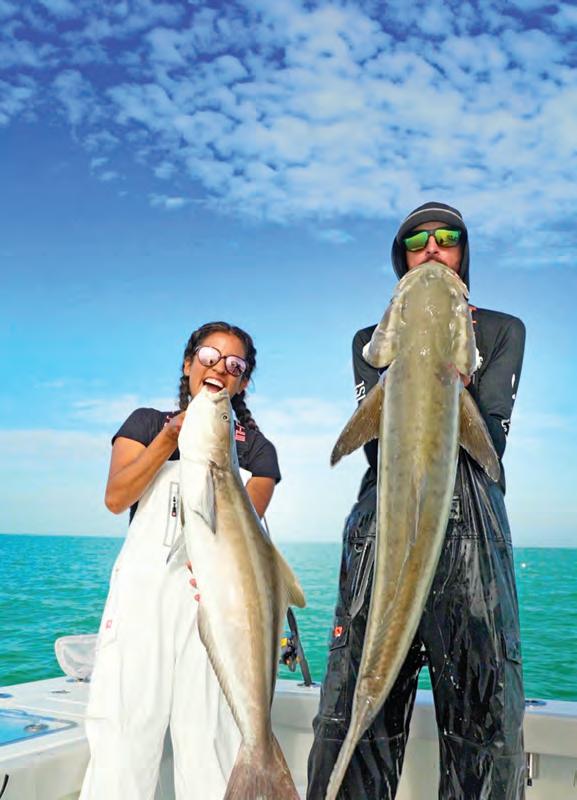 By A. deGruchy
By A. deGruchy
Cobia are robust, daring, and always up for a challenge. You know you’re in for some fun when you spot them cruising near the surface, sometimes in pairs or groups, hounding baitfsh like a wolfpack or drawn in by curiosity at the action around your boat. If you’re geared up and ready for them, a little fnesse will have you luring them in like a pro.
Location is key. When fshing for cobia in the backcountry here in the Florida Keys, we look for them to be around structures, wrecks and foating debris, ofen roaming the same areas in groups. Tey’re not pickiest eaters. Pitch a live bait out in front of them, and they’ll usually eat it, and we’ve also had great success with a Savage Gear RTF 3D Shrimp.
Te action when using these Savage Gear shrimps is a hard jerking lif, then letting your shrimp fall, mimicking a shrimp’s natural actions. For the battle, the optimal gear is at least a 4500 reel, but you really don’t need more than a 6500, and we always trust our Penn Authority and pair it with a medium/medium-light Carnage III Rod for maximum control and power.
Te most important thing to remember when hooking a cobia is to be ready, as it’s very common to spot “following” cobia. Tey ofen travel together and like to investigate what your hooked cobia is doing and eating. Tese “followers” can lead to an epic double header, but only if you have enough rods rigged and ready on the boat and hands to cast them.
Cobia are known for powerful runs, ofen scoping up and switching directions in a split second. Keep calm, adjust your drag, and let them exhaust themselves. Stay alert as you reel in your cobia, as they are known for sudden maneuvers, and will sometimes dart under the boat in a heartbeat. And the fght doesn’t end even afer you’ve gafed a cobia. Exercise caution when you bring them over the rail and onto the deck because they ofen cause havoc on the boat. It’s best to tire them out completely during the fght to minimize potential damage.
Since regulations frequently change with cobia, staying informed is important. One keeper cobia can feed a lot of people. Teir meat is known for its steak-like texture and delicate favor, perfect for a mouthwatering sear with butter and seasoning.
For the best shot at spotting a cobia, consider booking a full-day charter. Tis helps your chances to see one, and the timing should be pretty solid for in the upcoming weeks.
Book a charter at www.beansportfshing.com and follow their cobia adventures at “Bean Sportfshing TV” on YouTube.
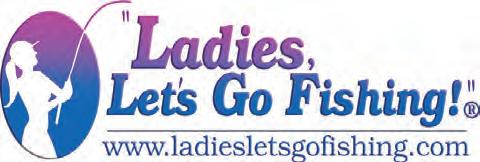


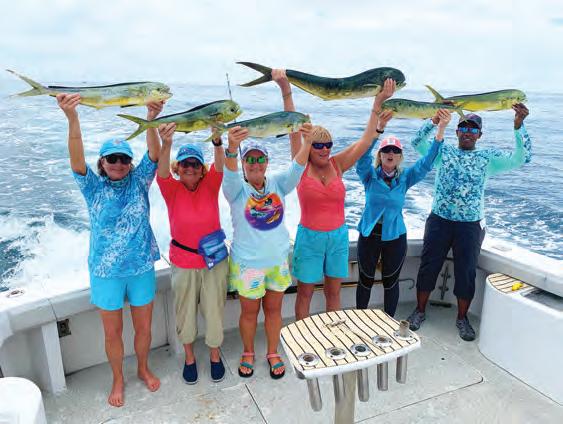
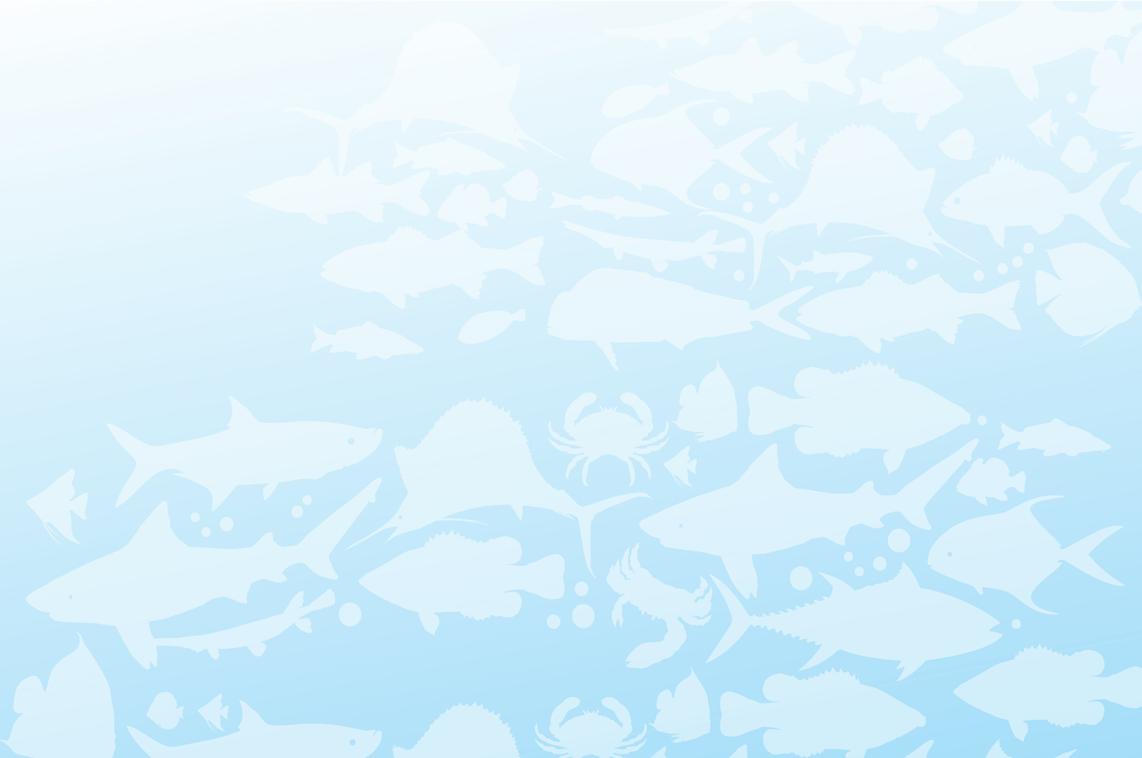


Along with blooms on the trees and frogspawn in the ponds, the annual rites of spring include an uptick in anglers reporting heavyweight catches.
A spate of recent record catches marks the transition to longer days, warmer weather and spring-spawning species putting on weight. In Indiana, an angler caught a monster 8-pound, 4-ounce smallmouth bass that crushed the existing state record by a pound. In Kentucky and Georgia, two anglers boated big yellow perch. Te Kentucky perch set a new state record, while the Georgia fsh earned the angler a tie for the heaviest perch ever caught in the Peach State.
In Indiana, angler Rex Remington caught his big pre-spawn smallie on March 3 at Monroe Reservoir. Te fsh was weighed on certifed scales in the presence of Indiana DNR ofcials before being released. Te new record was adopted a couple weeks later and is listed at 8 pounds, 4 ounces, beating a record that had stood since 1992. Te all-tackle world record smallmouth weighed 11 pounds, 15 ounces. It was caught from Dale Hollow Lake, Tennessee in 1955.
Smaller, but no-less-impressive, Lynn Bumgardner caught his 1.58-pound Kentuckyrecord yellow perch at Lake Barkley on March 2. It beat the existing 1.44-pound record caught in 2010. He was trolling grubs for crappie and knew
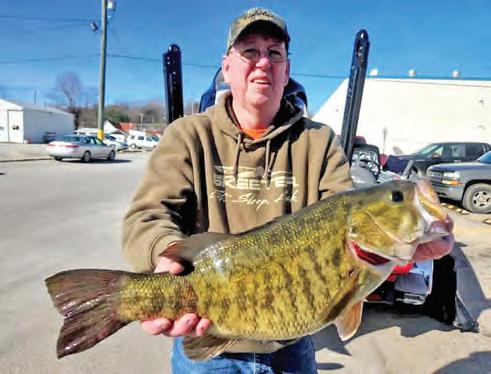
he had a heavy fsh when it hit, but he didn’t realize it was a potential record perch until it surfaced. Te fsh was 14.25 inches long.
Tey must grow perch bigger in Georgia. On Feb. 18, Emerson Mulhall caught a huge 16-inchlong, 2-pound, 9-ounce yellow perch that tied the existing state record set in 2013. Mulhall, who usually bass fshes at north Georgia’s Lake Burton was initially confused, because the fsh he’d hooked didn’t fght like a bass. When he realized it was a perch, his father convinced him to get of the lake and go get it weighed on certifed scales.
Te all-tackle world record yellow perch is reported by IGFA to have weighed 4 pounds, 3 ounces. Tat fsh was caught in New Jersey in 1865.
For more record fsh, go to coastalanglermag.com.
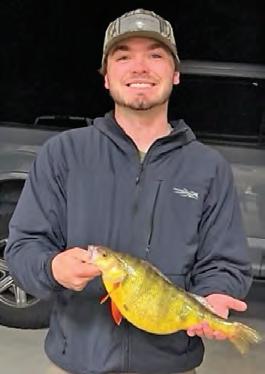





In some parts of the country, the bass spawn is already coming to an end like it is down here in Florida. In others the post-spawn might not start up for another couple months. Regardless of your phase, this post-spawn fshing tip should help you dial in your fshery when the time is right for you.
One thing is the same for every fshery and every species of bass afer they spawn, they are hungry! Tis can create some awesome and fun fshing opportunities. Post-spawn bass have provided some of my best days on the water.
Typically, afer the largemouth bass spawn, there are other fsh that begin their spawn. I’m not a scientist, but I’m sure this has a lot to do with the specifc timing of why bass do their thing when they do. In most areas of the southern United States, bluegill and ofentimes shad start to spawn very shortly afer the bass fnish up. Afer a long couple weeks or months protecting eggs in the shallows, bass use every advantage they can to feed when these baitfsh group up, and this can make for some fun fshing.
Smallmouth bass and spotted bass in the post-spawn phase are very similar to largemouths when it comes to taking

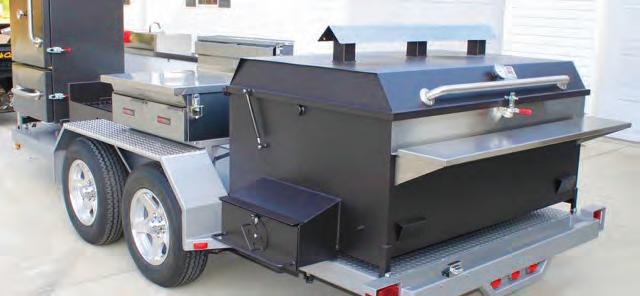
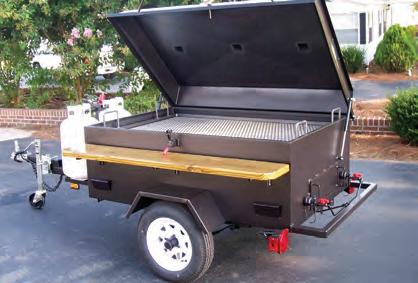
advantage of bait schools. I have seen them group up and attack shad, perch and alewife schools and any other bait that is readily available. Typically, I do a lot of my searching for these things with my electronics and forward-facing sonar, which is a very helpful tool for learning fsh activity and seeing what’s going on under the surface of the water.
Most of the time you don’t necessarily need electronics. You can use clues visible to the naked eye to help you fnd this “feed” that is going on. Birds feeding on the water is an awesome sign of a feeding frenzy, and it’s one thing I always look for. Also, always keep your eyes peeled for fsh blowing up on the surface or shad fickering under the surface. Sometimes the very smallest clue can lead you to much larger picture. Birds standing on specifc banks, the sound of bluegill popping around vegetation, anything that clues you in to bait in the area usually means the bass aren’t very far away.

Hopefully this tip will help you when the fsh in your area get into the post-spawn feed. Find the bait, and you will fnd the bass!
I try to imitate the prevalent baitfsh with whatever kind of lure I’m throwing. For bluegill eaters, I will throw a frog or a swimjig in bluegill colors. For shad eaters, I will throw white or silver topwaters and crankbaits.
Always match the hatch if possible. Good luck out there this season, and tight lines!
Tyler Woolcott is a professional tournament angler and guide. Check out his website at www.tylerwoolcottfshing.com.
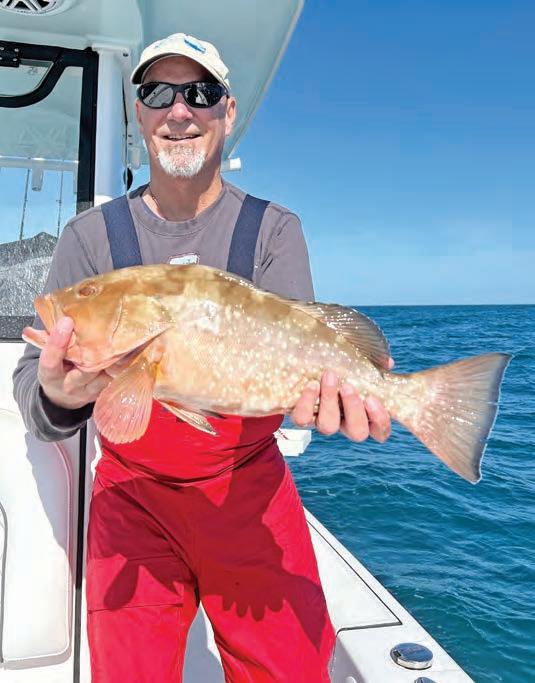 By Will Schmidt
By Will Schmidt
With gag grouper closed until late summer for many of us, it is time to be out looking for red grouper to fll our tacos this spring and summer. Fortunately, they are aggressive eaters if you’re willing to make the extra efort to go to their feeding grounds. In general, to get to decentsized reds, you’ll need to head a bit farther out, with the best fshing being found in 80 feet or deeper, especially as the water warms. You are still looking for the same type of environment; Swiss cheese bottom, ledges and artifcial reefs can all hold good numbers of quality fsh.
Te tactics are the same and simple. Tey will eat dead or live bait in most cases. Tat said, I found a combination of the two to be the best bet. I like to start with “stinky bait.” Dropping some frozen squid or menhaden is a great way to get the bite going. Once the bite starts, which is usually quickly if they are around, I like to switch to palm-size live pinfsh to entice the bigger fsh. While dead bait and jigs will certainly get you keepers, the larger fsh are quicker to hit a live bait.
Rigs are simple. Circle hooks must be used with natural bait and 5/0 to 7/0 hooks will do the trick. I prefer to use about 2 feet of leader, then a swivel and my weight, and a knocker rig will also work. A minimum of 50-pound fuorocarbon leader is recommended, as they will run for a hole in the rocks once hooked. Keep a close eye on your leaders, as they tend to get chafed when the fshing is good.
Even though red grouper are typically smaller than gags, I still use my goto big grouper set up, as at these depths you could get a big gag or other sea monster. Fortunately, new lighter combos like the Accurate BV600 reel and 70H rod make a full day of fshing more fun and less fatiguing. Tese two-speed reels have a patented twin drag that will stop the hardiest of fsh, and with that winching power you can use a lighter more parabolic rods to handle the biggest of bottom fsh. Line is important too. Te lack of stretch in braid is a must for landing big grouper. A minimum of 65-pound test, and a metered braid like the Nomad Panderra 8x is great for knowing how close you are to the bottom. Moreover, these rods are sensitive enough to do double duty as trolling rods for kings, sails and mahi.
While they might not be quite as big as some of their cousins, red grouper are great table fare, and it is hard to turn down a grouper taco, no matter what variety it is.
Will Schmidt is a seasoned tournament angler who has been writing about fshing from more than two decades.

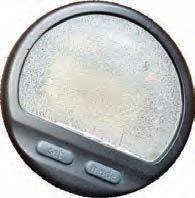








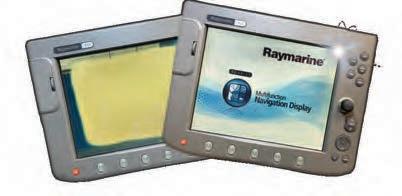







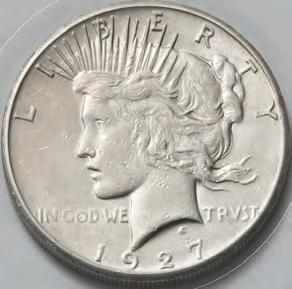







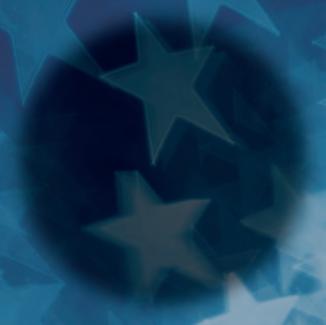





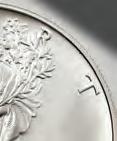
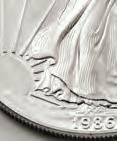

The heritage of American Silver Dollars is rich and diverse, marked by stunningly beautiful designs, leading to an enduring desirability in the hearts of collectors around the world. In this iconic U.S. Silver Dollar set, spanning nearly 150 years, you’re getting FIVE American Silver Dollars issued over the last 15 decades that each reflect the history, culture and economic aspects of the United States.
Each of these U.S. Silver Dollars is sought-after by collectors individually, but this set includes every design of U.S. Silver Dollar in American history, issued from 1878 to 2024!
Morgan Silver Dollar: First struck 146 years ago in 1878, the Morgan has a historic legacy as the coin that helped build the American West. Minted until 1904, then again in 1921, this 90% silver coin with its iconic Lady Liberty design is the most collected vintage Silver Dollar in the world. Extremely Fine (XF) condition coin included in set.
Peace Silver Dollar: With a beautiful design memorializing peace following the end of World War I, the 90% silver Peace Dollar was intended as a one-year only release struck in 1921—but it proved so popular with the American people, it was struck until 1928, then again in 1934-35. Extremely Fine (XF) condition coin included in set.

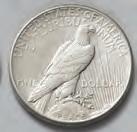
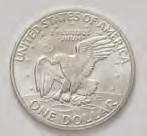
Eisenhower Dollar: The last circulating U.S. dollar coin, the Eisenhower Dollar, aka the “Ike Dollar,” was prized by Americans, with its design featuring war hero President Dwight D. Eisenhower, backed by an image symbolizing the Apollo II moon landing. First struck with silver 1971-1976, the Eisenhower Dollar in this set was struck in 40% silver for collectors, and you will receive a coin in Brilliant Uncirculated (BU) condition.






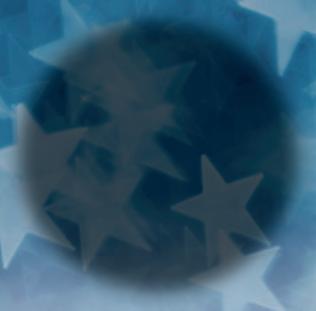







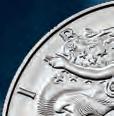



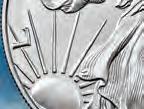





Silver Eagle Type 1: The first-ever U.S. Silver Dollar minted in 99.9% silver, these coins were first minted in 1986 following President Ronald Reagan’s signing of the Liberty Coin Act into law on July 9, 1985, which authorized the U.S. Mint to strike America’s new silver bullion coin. This gorgeous Silver Dollar features the original, revered Type 1 “Heraldic Eagle” reverse design by John Mercanti, 12th Chief Engraver of the U.S. Mint. Brilliant Uncirculated (BU) condition coin included in set.
Silver Eagle Type 2: In honor of the popular 99.9% silver coin’s 35th anniversary in 2021, the Silver Eagle received a new, esteemed Type 2 “Eagle Landing” reverse design. This is the current issued coin by the U.S. Mint. Brilliant Uncirculated (BU) condition coin included in set.
SAVE with this Ultimate U.S. Silver Dollar Set! You’ll save both time and money on this 150 Year U.S. Silver Dollar Set, with FREE SHIPPING and a BONUS presentation case, plus a new and informative 150 Years U.S. Silver Dollars booklet! Call right now to get yours before they’re gone!



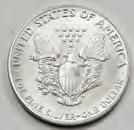





Ultimate U.S. Silver Dollars Set — Regular





